Publications by Geoff Hanmer: Managing Director of ARINA and Adjunct Professor of Architecture at the University of Adelaide
@geoffhanmer
The Australian: Higher Education Supplement
The Conversation
Refer also to the Conversation for Article Attributes, Creative Common Licensing and Disclosures
[Click Publication Titles below to Show/Hide]
Why universities may come to regret the costs of City Deals and private sector ‘solutions’
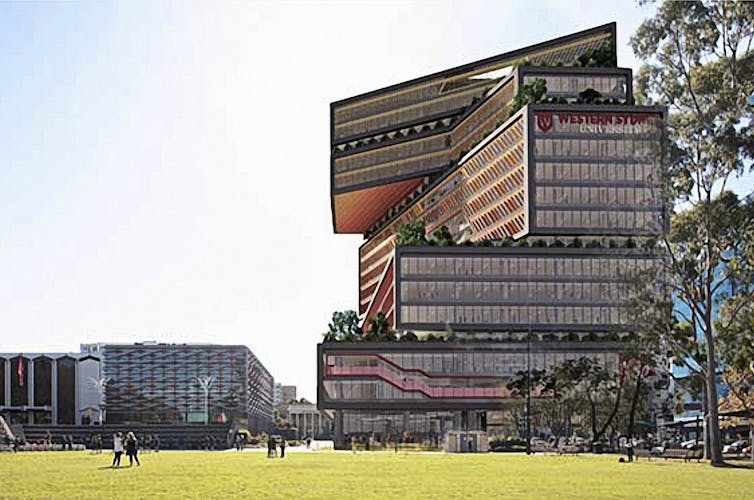
Universities have had few sources of capital funds since the Abbott government sidelined the Education Investment Fund in 2014. The loss of an estimated A$16 billion of income by 2023 due to the COVID-19 pandemic has simply added to this problem.
The City Deals process is one option, but for most universities it’s a poisoned chalice. A university will have to make a large financial contribution to the project and bears the risk of any cost overruns. These deals were conceived in the salad days prior to 2020 and now look decidedly wilted.
Read more: Think big. Why the future of uni campuses lies beyond the CBD
How do these City Deals work?
The Perth City Deal, for example, includes a $695 million project for Edith Cowan University. With the Commonwealth providing $245 million and the state government $150 million, ECU must stump up $300 million and hand over its perfectly serviceable Mount Lawley campus to the state government. The upshot is that the university will spend much more than would be needed to upgrade that campus for the dubious benefit of moving it 6km to the CBD.
The Australian Department of Infrastructure describes City Deals as “a genuine partnership between the three levels of government and the community to work towards a shared vision for productive and liveable cities”. The Perth deal is clearly a boost for the CBD and the Western Australian construction industry. The benefits to teaching or research at ECU are less easy to identify.
The Darwin City Deal commits Charles Darwin University (CDU) to a new campus in the Darwin CBD. CDU teaches 70% of its student load online, but it will end up with four campuses in Darwin with a combined capacity of well over 10,000 students to teach the 4,000 enrolled for on-campus study. The prospect of more students from China, which was a key component in planning for the project, has disappeared.
The deal required CDU to take out a $151.5 million loan from the Northern Australia Infrastructure Facility (NAIF). While the interest rate is low, the capital component must be paid back.
Again, this project is a boost for the Northern Territory construction industry, but it may well reduce CDU’s capacity to spend on teaching and research. As a result of longstanding financial pressures, CDU has already sacked 77 staff and scrapped courses.
Read more: A fad, not a solution: 'city deals' are pushing universities into high-rise buildings
Another option is to spend nothing on infrastructure. The University of Adelaide has announced a complete halt to such spending for the foreseeable future. It still plans to attract “top talent” with its ageing facilities. Quite how this will work is unexplained.
Developers are in it for the profits
Other universities have struck deals with developers. These can range from selling university assets and leasing them back, or signing up to a long-term lease on new purpose-built space using a special purpose vehicle (SPV), doing developments using university land, or other financial wizardry.
Charter Hall, a real estate investment company, has signed up Western Sydney University to several deals with a combined value of around a billion dollars. A new $350 million campus is being built in the CBD of Bankstown.
Charter Hall has openly said its aim is to create a new asset class in university buildings and campuses. This approach effectively privatises campus assets, nearly all of which were paid for with public money and charitable donations.
Western Sydney University is selling a newly built neighbourhood shopping centre and an adjoining residential development site. This was developed with Charter Hall on land controlled by the university, which says: “The Caddens Corner project is part of the Western Growth strategy, reshaping the University’s campus network, and allowing the University to maximise its investment in the core university activities of teaching, engagement and research.”
This is an interesting proposition, as teaching, engagement and research are all essentially operational, not capital, costs. In other words, the university is selling public assets to fund recurrent costs while planning to have 13 campuses to educate not many more students than Macquarie University, which has one.
Read more: 3 planning strategies for Western Sydney jobs, but do they add up?
In Melbourne, Swinburne University has put a seven-storey office building on Flinders Lane back on the market just one year after buying it for $44 million. In June, RMIT University in Melbourne brought forward plans to offload a 14-storey strata property on Bourke Street for more than $120 million and lease it back for five years.
A good time to borrow and build
Certainly, getting a developer to build a facility and lease it back to the university will reduce the need for capital. For similar reasons, a low-income household might choose a rental purchase arrangement to get a flat-screen TV. But like any rental purchase agreement, the short-term benefits pale in comparison to the long-term costs.
And universities are certainly about the long term. Four universities in Australia are more than 125 years old and they are youngsters compared to Harvard (385), Leiden (436), Oxford (925) or Bologna (933).
Read more: A century that profoundly changed universities and their campuses
Another option for universities is to borrow money from a bank. If the universities can’t afford to do that, then they can’t afford to get developers to borrow money on their behalf and build them buildings while the developers also make a profit. There is no secret sauce and definitely no magic pudding.
Borrowing to fund the replacement or refurbishment of buildings at the end of their economic life is financially prudent providing benefits outweigh costs. University leaders might need to learn how to resist the temptation to make every building an “icon”, but capital investments to support teaching and research are rational and responsible. With interest rates as low as they will ever be and building costs a long way below the peak of the next cycle, now is an ideal time to build.![]()
Geoff Hanmer, Honorary Professional Fellow, Faculty of Design, Architecture and Building, University of Technology Sydney
This article is republished from The Conversation under a Creative Commons license. Read the original article.
Think big. Why the future of uni campuses lies beyond the CBD
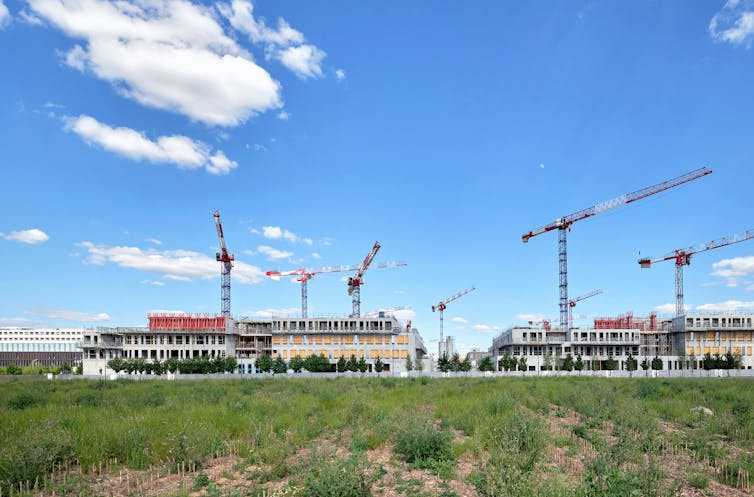
This is the second of two articles on the past and future of the university campus.
The “dreaming spires” of Oxford University that Matthew Arnold romanticised in 1865 still have a powerful grip on our image of the university. Nevertheless, the university town is part of the past. A key reason for this is the expense of developing facilities on a confined site, particularly in a heritage setting.
Read more: A century that profoundly changed universities and their campuses
The new Beecroft physics building at Oxford is ten storeys high but five are below ground because of government-imposed height restrictions. Unfortunately, this configuration requires a large percentage of floor space to be devoted to stairs, lifts and ventilation ducts. Although the building costs about £5,500 (A$9,840) per square metre of gross floor area, the cost per usable square metre is an eye-watering £15,000. That’s about double the going rate for this type of building on a large-area campus.
The new Cavendish Laboratory at Cambridge will cost £300 million for similar reasons.
Expansive campuses dominate overseas
In the 1970s, the University of Heidelberg moved from its site in the town of Heidelberg to a new 112-hectare campus on the north bank of the Neckar River. This enabled the university to develop new space, particularly laboratory space, at economical cost. In the decade after 2007, Heidelberg rose from between 51st and 75th in Science on the Academic Ranking of World Universities (ARWU) to 39th. Oxford slipped from tenth to 13th and Cambridge from fourth to seventh.
Of the No. 1 universities in the 54 subjects tracked by the ARWU, including humanities subjects, 84% occupy large campuses of 50 hectares or more.
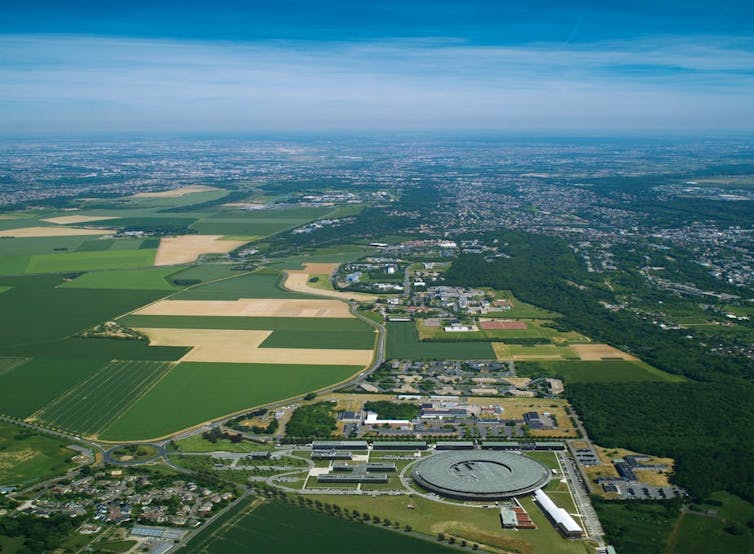
The most interesting campus development in the world at the moment is the University of Paris-Saclay. The French government is grabbing the best bits of the University of Paris and assembling them into a super research university. Intended to rank within the ARWU top ten, it is already first in mathematics and 14th overall.
Read more: Why France is building a mega-university at Paris-Saclay to rival Silicon Valley
Paris-Saclay is located on 189ha of farmland south of Paris, close to a railway station. It’s the classic large-area campus. Next to the campus lots of cheap land has been made available for startup companies that will be spun out of the university or existing companies that relocate to use its research or facilities.


It is another attempt to recreate Silicon Valley, and there’s every reason to try. As part of research by ARINA, an architectural firm specialising in higher education, community and public design, a simple mapping project shows 67% of the market capitalisation of US Fortune 500 Tech companies is located in the triangle between San Francisco, Oakland and San Jose. Two top ten universities, Stanford and UC Berkeley, are also located there.
Similarly, in the UK, a belt of high-tech and new-economy industries stretches from Bristol through Oxford, Milton Keynes, Bedford and Cambridge. Also located here are the ARWU top 100 universities of Bristol, Oxford and Cambridge and the nearly-there Warwick.
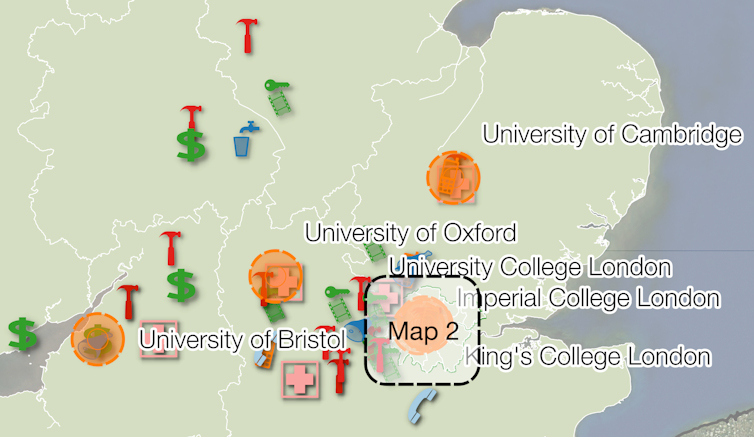

More than 50% of the market capitalisation of companies in the FTSE Tech 100 are also located in this area. Only 17% of companies in this index are located in Greater London, and none in central London.
UCL (formerly University College London) is building a new large-area campus at UCL East on the former London Olympics site in Hackney. Its aim is to ease pressure on the 9.7ha UCL campus in Bloomsbury and to provide opportunities for partners to be located close by.
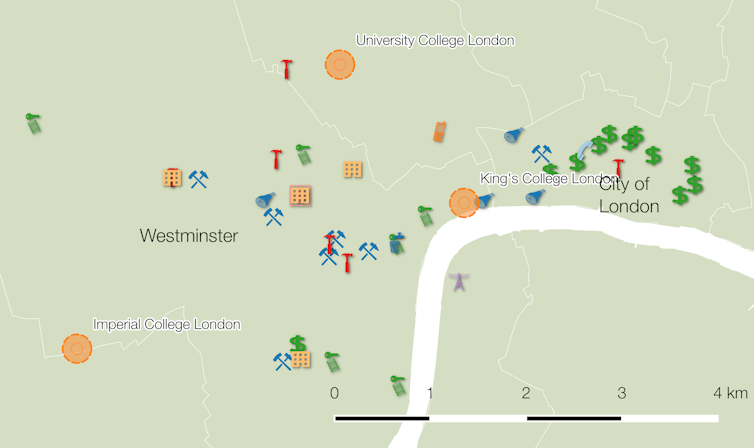
What about Australian developments?
In Australia, our most recent efforts at building campuses are a mixed bunch.
The new Western Sydney “Aerotropolis” and the new University of Melbourne campus at Fishermans Bend in Melbourne are plausible because they are expansive campuses with land for partners to invest in nearby facilities. Delivering low and mid-rise buildings on less expensive land served by public transport seems like a good bet.
Macquarie University’s role in the Macquarie Park business and innovation district in Sydney and Deakin’s Waurn Ponds campus in Geelong have successfully attracted private investment and provide evidence that this concept can work.
Other universities have demonstrated how to mess this up. UNSW built a new building to accommodate a commercial partner in photovoltaics. Unfortunately the commercial partner then dropped out. The university was left with a large bill and an empty building.
The key lesson of this, and many other initiatives, is for the university (and government) to deliver attractive intellectual property but to avoid investing in building facilities that the private sector might occupy at some unspecified time in the future. In other words, don’t build and expect them to come.
There are proposals to move the University of Tasmania’s Sandy Bay campus to the Hobart central business district, to create a new CBD campus in Darwin for Charles Darwin University and to shift Edith Cowan University’s Mt Lawley campus into the Perth CBD. As I have argued before, all these proposals are a response to a trend encouraged by the development industry rather than a rational response to issues confronting the higher education sector.
Read more: A fad, not a solution: 'city deals' are pushing universities into high-rise buildings
Look where world-changing products were born
ARINA research suggests the economy in CBDs is increasingly focused on banking, finance, insurance, property development, accounting and consulting – rentier industries built on income from property or securities that depend on government rather than research to prosper. These are not industries that need a helping hand to grow and they are not industries that initiate change. Putting university campuses physically next to them is pointless.
With its key product, the iPhone (launched in 2008), Apple has probably done more to change the world than any other corporation in recent times. It has done so from a campus in Cupertino, roughly midway between San Jose and Stanford University.
The research that has produced the Pfizer COVID-19 vaccine originated in Mainz, Germany, population 217,000. The research for the AstraZeneca vaccine was carried out in the outskirts of Oxford, UK. Moderna’s research facilities are in Cambridge, Massachusetts, near MIT.
Most of the things that have made a difference start in sheds (Boeing and Douglas aircraft companies) or garages (Apple, Google and Hewlett Packard), or cheap office space (Intel).
I start and finish these articles with the observation that it costs about half as much per delivered square metre to build on a large-area campus. Low to mid-rise buildings have more usable space per gross sq m, are more sustainable because they use less embodied energy and are inherently more adaptable.
A very large campus provides space to develop facilities that will be required as research evolves over time. The surrounding land is cheaper and therefore more attractive to the firms that might draw on university research. That’s the “secret” of both Silicon Valley and the UK high-tech belt. And it’s why the University of Paris-Saclay will work.
In Australia, we should contemplate why the Bay Area is so successful, learn from the example of the University of Paris-Saclay and rethink our obsession with CBD campuses.![]()
Geoff Hanmer, Adjunct Professor of Architecture
This article is republished from The Conversation under a Creative Commons license. Read the original article.
A century that profoundly changed universities and their campuses
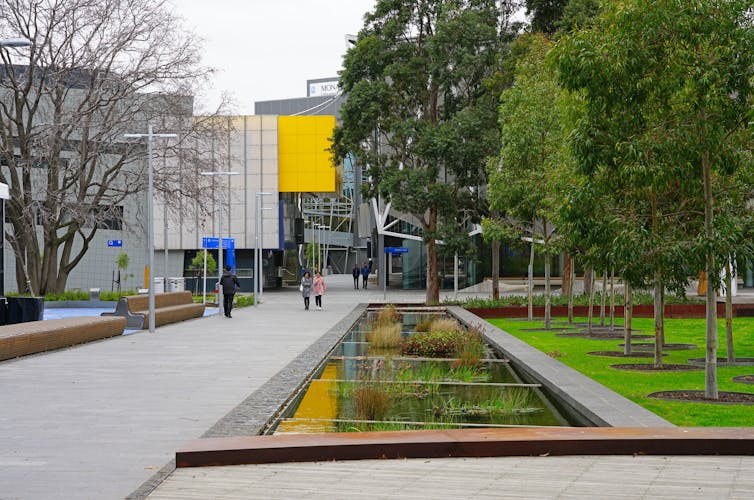
This history of the development of universities is the first of two articles on the past and future of the campus. This is a long read, so set aside the time to read it and enjoy.
Once the first atomic bomb exploded on July 16 1945 in New Mexico, the world would never be the same again. Scientists and engineers had turned an obscure principle into a weapon of unprecedented power. Los Alamos, the facility where the bomb was designed, was run by the University of California.
This was a turning point for universities. As they increasingly focused on scientific research, the role of universities worldwide – and their campuses – changed.
Before the first world war, the largest investment on most campuses was the university library. After the second world war, investment shifted decisively to laboratories and equipment.
A key reason for the increasing focus on university research was the lessons of the first world war. After the war, governments of rich countries took an increasingly interventionist role in directing and encouraging the research and development of artificial materials, weapons, defences and medicine. Universities or institutes associated with universities did much of this work.
Read more: Universities and government need to rethink their relationship with each other before it's too late
By 1926, the Council for Science and Industrial Research, the predecessor to the CSIRO, and the organisation that would become the National Health and Medical Research Council (NHMRC) had been founded in Australia.
A gradual turn towards research
In the UK, many of the older universities were not that keen on applied research. Chemistry, engineering and physics were taught at Oxford between the wars, but by 1939 the chemistry cohort was just over 40 students, of whom “two or three were women”.
It wasn’t until 1937 that Oxford drew up a plan to develop the “Science Area” with new buildings, but in that same year, the university also agreed to reduce its size to avoid a fight with the Town over “further intrusion on the Parks”.
Facilities at Cambridge for physical sciences were slightly better, but not by much, despite its historical focus on mathematics. The Cavendish laboratory in which the New Zealander Ernest Rutherford discovered in 1911 that the atom had a nucleus was small, dark, damp and ill-equipped.

This relative lack of interest in experimental sciences at Oxbridge was unhelpful for science research in Australia, because our six small state-run universities tended to follow their lead. As an indication of its priorities, the University of Adelaide built its humanities buildings in stone and its much more modest science facilities in brick.
Nobel laureate and University of Adelaide Professor W.H. Bragg carried out his pioneering experiments on X-ray crystallography in Adelaide during 1900 to 1908 in a converted storeroom in the basement of the Mitchell Building. His lab is now a storeroom again.
The post-war transformations
The application of university research had been a German strength since well before the first world war with the rise of the Humboldtian model of higher education, which favoured research over scholarship. A key reason the Allies prevailed in 1945 was that the United States in particular rapidly improved its capacity to carry out and apply research, based on the Humboldtian model.
In 1917, MIT established a naval aviation school. The University of Washington soon followed MIT’s example.
This decision had a direct bearing on the success of the Boeing company following construction of the Boeing wind tunnel at the University of Washington’s Seattle campus in 1917. It led directly to the development of advanced aerodynamics for the Boeing 247 of 1933, which provided the template for all subsequent commercial airliners.
The Australian university system between the wars offers no such exemplars. The focus on applied research was foreign to the prevailing university culture in Australia at the time. As Hannah Forsyth writes in A History of the Modern Australian University, not until the 1940s did “scholarly esteem began to move away from ‘mastery’ of disciplines towards the discovery of new knowledge”.

New research facilities and new campuses
New technologies led to a host of new post-war industries, including commercial aviation, television, plastics, information technology (IT) and advanced health care. The demand for skills to operate these new industries was the primary driver of an explosion in university enrolments.
University science research in Australia only got a serious start in 1946 with the foundation of the Australian National University (ANU) and the Commonwealth Universities Grants Committee, which became the Australian Research Council (ARC).

As Robert Menzies, the prime minister from 1949-66, later wrote:
The Second World War brought about great social changes. In the eye of the future observer, the greatest may well provide to be in the field of higher education.
In Australia, about 80% of our universities have been founded since the second world war. The growth of the sector has been startling.

Read more: Australia doesn't have too many universities. Here's why
All of the institutions founded during the Menzies era were sited on large campuses in the suburbs or beyond. Although mainly Commonwealth-funded, they were designed and delivered by state public works authorities to tight budgets on land provided largely by state governments. UNSW, Monash, Griffith, La Trobe, Flinders and WAIT (now Curtin) share a heritage of economical buildings on large parcels of land.
The key reasons for this approach were to minimise cost and maximise capacity for growth and change. Low to medium-rise buildings on land surplus to state needs maximised bang for buck. Development costs per square metre of building were about half that of a campus in the central business district (CBD) of cities.
This was not a new discovery. The universities of Stanford, Berkeley, Caltech, Tokyo, Wisconsin and Peking, all founded in the 19th century, used this model for similar reasons.
Fortunately, the states were generous with land they didn’t need. Of all the universities built in the Menzies era, only UNSW with 39 hectares has a significant land area constraint. The other universities have at least 50ha and several have well over 100ha. This has given them some headaches, but also lots of options.
Research by ARINA, an architectural firm specialising in higher education, community and public design, shows that virtually all universities built since 1949 – that’s more than 90% of universities in the world – have large campuses with densities less than 500 students per hectare. The University of Bath, built in 1966, is typical of post-war UK universities with 59ha and 16,000 students in 2021, less than 300/ha.
The same is true even in small city-states such as Hong Kong and Singapore. The National University of Singapore has a campus of about 140ha with 37,000 students (264/ha) and Hong Kong University of Science and Technology has 55ha with 11,000 students (200/ha).
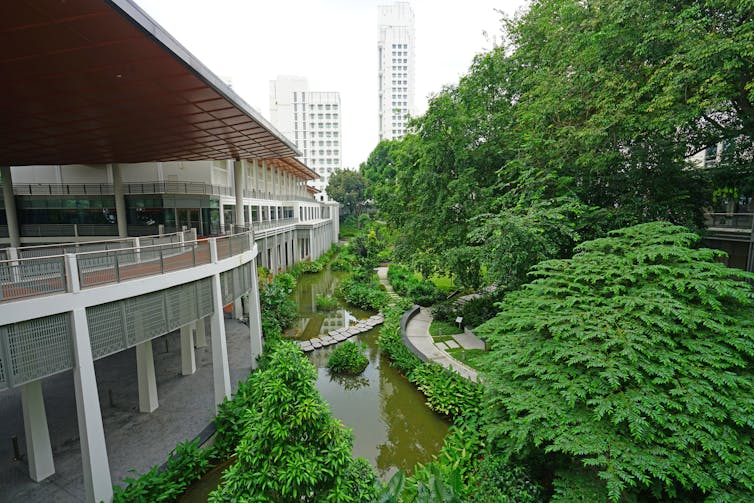
Most new universities in Europe, Asia, India and the Middle East still rely on the large campus model. The University of Paris-Saclay, for example, is being built on 189ha of former farmland 15km south of the Paris orbital motorway.
Broad-acre campuses are popular with students as measured by surveys of educational experience such as the Australasian Survey of Student Engagement (AUSSE) and the US National Survey of Student Engagement (NESSE). The most popular campuses in Australia are Bond, New England, Griffith and Notre Dame. RMIT and UTS, the highest-ranked CBD campuses finish in the middle of the pack, a long way behind the leaders. A similar phenomenon can be seen in the UK and the US.
Read more: Looking beyond the sandstone: universities reinvent campuses to bring together town and gown
Campus model goes corporate
The ARINA research indicates broad-acre campus models have also become increasingly part of the physical organisation and accommodation of many commercial operations.
In 2020, 63% of the top 30 US Fortune 500 index and 87% of the top 30 tech companies in the index were located in suburban and extra-urban settings, mostly campuses. This includes well-known tech companies such as Apple, Alphabet, Facebook, Tesla and HP, but also less obvious candidates such as Walmart, Exxon Mobil and Amazon.
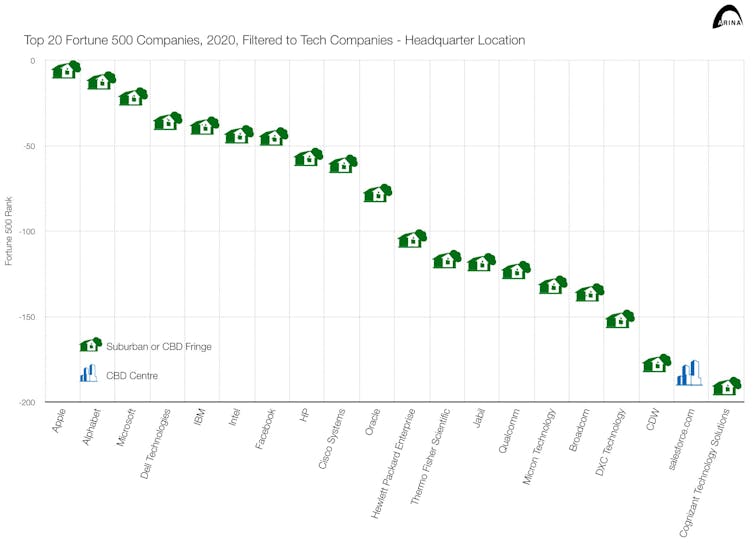
In the UK, 28% of all FTSE 100 companies and 54% of FTSE Techmark 100 companies by market capitalisation are based outside greater London.
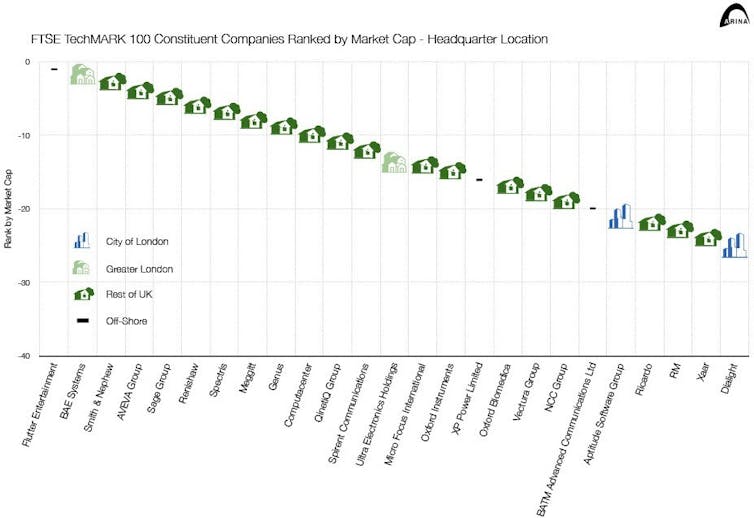
The reasons for this are straightforward: capital and operating costs for research-based firms are lower outside a CBD. While some Australian universities are choosing to head into the city, much of the new economy appears to be heading for the suburbs. It’s happening for the same reason that universities started to migrate there over a hundred years ago.
Read more:
The rise of the corporate campus
![]()
Geoff Hanmer, Adjunct Professor of Architecture
This article is republished from The Conversation under a Creative Commons license. Read the original article.
News of the collapse of the Grocon empire is greatly exaggerated
Geoff HanmerGrocon, the Australian construction empire that grew from the family concreting business started by Luigi Grollo in Melbourne in 1948, is on its last legs.
But Grocon, the privately held property development empire headed by Luigi’s grandson Daniel Grollo, will continue to operate.
Media outlets have breathlessly reported Grollo’s announcement that Grocon’s construction business is insolvent, meaning it is no longer able to pay its debts, and that external administrators have been called in (as the law requires) to sort out if the business can be sold or its assets liquidated to pay off at least some of what is owed.
The Grocon group, though, is more than a construction business, having found better money-making opportunites in property development and being a landlord. It is a web of many legal entities and holding companies.
Exactly how much of the web is being put into administration is not yet clear – as a private company, disclosure requirements are fewer than those for public companies (listed on a stock exchange).
But based on Grocon’s track record – and common practice in the Australian building industry – the most likely upshot is that Grocon will cut its losses on ailing entities without affecting the profitable parts of the greater empire.
One thing seems sure, though. Daniel Grollo and other executives will not be at risk of losing their homes and livelihoods. The real losses will be felt by others.
Development beats construction
Luigi Grollo’s construction business began with pouring concrete on small projects. As time went by its projects got bigger. In the 1970s it moved beyond building for other entities into property development on its own account – acquiring land, gaining development approval, building and then selling or leasing the finished product.
Development, which requires a certain amount of vision, access to capital and solid political connections, is the route to making serious money.
Read more: Federal parliament just weakened political donations laws while you weren't watching
Construction, by comparison, provides limited opportunities for a big payday and plenty of opportunities to make a hash of it.
The landscape for Australia’s “Tier 1” builders – the contractors able to take on the largest projects – has been poor for several years.
Lendlease, for example, announced in December 2019 it was selling its engineering construction business to Spanish infrastructure conglomerate Acciona. The sale followed huge losses on projects such as the Melbourne Metro underground rail project and Sydney’s NorthConnex motorway tunnel project.
John Holland, the builder of Melbourne’s West Gate Tunnel and the Sydney Metro light-rail project, lost A$60 million in 2019. CIMIC Group (previously known as Leighton) made a net loss of A$1 billion.
Grocon’s Barangaroo stoush
The stated catalyst for Grocon’s announcement about its construction business is a legal dispute with Infrastructure New South Wales, the state authority overseeing the development of Sydney’s Barangaroo precinct. Different companies are developing and building different parts of the project.
In 2018 Crown Resorts and developer Lendlease fought and won a legal case against Infrastructure NSW over fears buildings being built by a Grocon-led consortium as part of the “Central Barangaroo” precinct would block harbour views from Crown’s casino hotel and Lendlease’s high-rise apartments in the “Barangaroo South” precinct.
Grocon subsequently pulled out (selling its interests to Chinese partner Aqualand). It is suing Infrastruture NSW for A$270 million in compensation for not informing Grocon it needed to factor in sight lines from the Crown Resorts and Lendlease buildings.
Grollo blamed Infrastructure NSW for “forcing our hand to place the construction business into administration”:
While I have spoken before about moving Grocon away from the construction business model to new initiatives such as build to rent, I did not want to call in administrators.
But Grollo has said such things before.
In October last year Grocon put two subsidiaries into insolvency over a dispute with commercial landlord Dexus involving A$28 million in unpaid rent for space leased in Brisbane’s 480 Queen Street building.
Grollo also declared he was doing this reluctantly but had been forced into it.
Australian Securities and Investments Commission records indicate 27 Grocon entities have been deregistered or cancelled since about 2006. That leaves, by my count, 31 registered companies. How many of these will now be placed in administration is unclear.
Read more: These private companies pay less tax than we do – but reasons remain unclear
A notorious industry practice
The construction industry is notorious for the use of insolvency and administration mechanisms, dominating the statistics out of all proportion to its share of the economy.
Many in the industry see it as a normal business practice.
It’s a cost-effective solution, but it leaves subcontractors and other suppliers owed money in the lurch. It creates waves of bankruptcies among smaller businesses – electricians, plumbers, plasterers and so on – who have often secured business loans with their homes. Many are left destitute. It helps explain the industry’s high suicide rate.
Read more: Is illegal phoenix activity rife among construction companies?
Privatising profits, socialising losses
Is it right for a big operator with substantial resources to slice and dice its operating companies to ensure it continues to prosper while its subcontractor and consultant creditors are ruined?
The construction union – with which Grocon has long battled – has called for a national scheme to compensate subcontractors when a head contractor goes bust.
But this is an invitation to continue to privatise profits and socialise losses.
The first step governments could take is to adopt procurement policies using value-based assessments rather than just choosing tenders based substantially on price.
They should also not try to transfer unmanageable risks to constructors and consultants, including setting unachievable budgets and programs.
This would encourage contractors to submit honest tenders and deliver quality projects without exploiting the smaller players they rely on.
Effective monitoring of downstream activities, including payments to subcontractors, is also vital.
If we are going to have a construction industry that does not rely on the public purse to pick up the pieces, we don’t need another inquiry or royal commission. We do need a co-ordinated effort to fix the obvious problems, including effective laws to stop insolvency and administration being standard business practice.
Administrators and liquidators should have readier access to the assets of other companies in a group and also the assets of directors.![]()
Geoff Hanmer, Adjunct Professor of Architecture
This article is republished from The Conversation under a Creative Commons license. Read the original article.
Many of our buildings are poorly ventilated, and that adds to COVID risks

The virus that causes COVID-19 is much more likely to spread indoors rather than outdoors. Governments are right to encourage more outdoor dining and drinking, but it is important they also do everything they can to make indoor venues as safe as possible. Our recent monitoring of public buildings has shown many have poor ventilation.
Poor ventilation raises the risks of super-spreader events. The risk of catching COVID-19 indoors is 18.7 times higher than in the open air, according to the US Centers for Disease Control and Prevention.
Read more: Poor ventilation may be adding to nursing homes' COVID-19 risks
In the past month, we have measured air quality in a large number of public buildings. High carbon dioxide (CO₂) levels indicate poor ventilation. Multiple restaurants, two hotels, two major shopping centres, several university buildings, a pharmacy and a GP consulting suite had CO₂ levels well above best practice and also above the absolute maximum mandated in the National Construction Code.
Relative humidity readings of less than 40% associated with both heating and cooling air are also of concern. Evidence now suggests low humidity is associated with transmission.
If anyone had COVID-19 in these environments, particularly if people were in them for an extended period, as might happen at a restaurant or pub, there would be a risk of a super-spreader event. Less than 20% of individuals produce over 80% of infections.
Read more: A few superspreaders transmit the majority of coronavirus cases
Many aged-care deaths were connected
It appears a relatively small number of super-spreader events, probably associated with airborne transmission of SARS-CoV-2, the virus that causes COVID-19, were responsible for most of the deaths in Victorian aged-care facilities.
Of the 907 people who have died of COVID-19 in Australia, 746, or 82% of COVID-19 deaths, were associated with aged care. In Victoria, there were 52 facilities with more than 20 infections. Three had over 200 infections. As a result, 639 of the 646 aged care residents who died in Victoria were located in just 52 facilities.
But official advice hasn’t changed
Aged-care operators and the states based their infection control on the advice of the Commonwealth Infection Control Expert Group (ICEG). As of September 6, the Coronavirus (COVID-19) Residential Aged Care Facilities Plan for Victoria stated:
Coronavirus (COVID-19) is transmitted via droplets, after exposure to contaminated surfaces or after close contact with an infected person (without using appropriate PPE). Airborne spread has not been reported [our emphasis] but could occur during certain aerosol-generating procedures (medical procedures which are not usually conducted in RACF). […] Respiratory hygiene and cough etiquette, hand hygiene and regular cleaning of surfaces are paramount to preventing transmission.
In early August, more than 3,000 health workers had signed a letter of no confidence in ICEG. The letter noted that aerosol transmission was causing infections in medical staff, many of whom worked in aged-care facilities.
On September 7, we wrote to the federal aged care minister, Richard Colbeck, drawing attention to our August 20 article in The Conversation, which referenced a July 8 article in Nature. The Nature article identified an emerging consensus that aerosol transmission of SARS-CoV-2 is probable in low-ventilation environments.
Read more: How to prevent COVID-19 ‘superspreader’ events indoors this winter
The director of the Aged Care COVID-19 Measures Implementation Branch wrote back on Colbeck’s behalf on September 28 saying:
Current evidence suggests COVID-19 most commonly spreads from close contact with someone who is infectious. It can also spread from touching a surface that has recently been contaminated with the respiratory droplets (cough or sneeze) of an infected person and then touching your eyes, nose or mouth.
In other words, Commonwealth authorities were still playing down the significance of airborne transmission nearly two months after the letter of no confidence was sent to ICEG and three months after the article in Nature. By the end of September, Victorian aged-care facilities had reported over 4,000 cases of COVID-19, about half of them in staff.
On October 23, ICEG was still saying:
There is little clinical or epidemiological evidence of significant transmission of SARS-CoV-2 (the virus that causes COVID-19) by aerosols.
Focus on the ‘3 Vs’ to reduce risks
The key thing we need to do until a vaccine is rolled out is to try to prevent indoor super-spreader events. According to the University of Nebraska Medical Centre, we should remember the “three Vs” that super-spreader events have in common:
Venue: multiple people indoors, where social distancing is often harder
Ventilation: staying in one place with limited fresh air
Vocalization: lots of talking, yelling or singing, which can aerosolize the virus.
Measuring indoor ventilation is quick and easy using a carbon dioxide detector. Any CO₂ reading of over 800 parts per million is a cause for concern – the level for air outside is just over 400ppm.
There is no excuse for governments, health authorities and building owners not to monitor ventilation levels to help ensure members of the public are as safe as is reasonably practicable when indoors.
There is also no excuse for the Australian Building Control Board not to change the National Construction Code to require fall-back mechanical ventilation systems be fitted and CO₂ and humidity monitored in all buildings frequented by the public, particularly aged-care facilities.
With the knowledge we have now and a low rate of community infection, Australia should be able to make it through to vaccine roll-out with relatively few further infections and deaths. But that depends on being vigilant about the quality of ventilation indoors and the associated possibility of super-spreader events. This is especially important in aged-care facilities and quarantine hotels.
It’s probably a good idea for us all to open the windows and let the fresh air in.![]()
Geoff Hanmer, Adjunct Professor of Architecture and Bruce Milthorpe, Emeritus Professor, Faculty of Science, University of Technology Sydney
This article is republished from The Conversation under a Creative Commons license. Read the original article.
A fad, not a solution: 'city deals' are pushing universities into high-rise buildings

Let’s talk about “city deals”. The Australian government is.
Its department of infrastructure website describes them as “a genuine partnership between the three levels of government and the community to work towards a shared vision for productive and liveable cities”.
The idea comes from the UK. There they award extra funding and special decision-making powers to local authorities who can demonstrate they will use them to boost economic growth.
So far Australia has had eight city deals, in Townsville, Launceston, western Sydney, Darwin, Hobart, Geelong, Adelaide, Perth and southeast Queensland.
This announcement about the western Sydney deal from federal urban infrastructure minister Alan Tudge and NSW minister Stuart Ayres is typical:
The Western Sydney Aerotropolis and Western Sydney International (Nancy-Bird Walton) Airport will attract infrastructure, investment and skilled jobs, and the benefits will flow into health and education, retail, hospitality and industrial activities that will power the region.
It’s one of 22 such announcements about the Western Sydney deal in the past two years.
The deal no vice-chancellor can refuse
Whatever their merits as a tool for planning, city deals are useful for making announcements about jobs, and also for spending money in electorates in which the government takes a special interest.
In western Sydney, four universities – one of them the University of Newcastle, which is hundreds of kilometres away – are being funded to develop a “Aerotropolis Multiversity”.
Read more: City Deals: nine reasons this imported model of urban development demands due diligence
City deal funding is funding no university can resist, in part because it is now about the only way they can get money from the federal government for buildings.
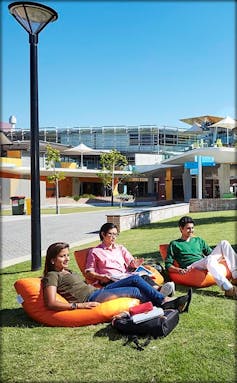
The new Perth city deal requires Edith Cowan University to relocate to the central business district to “kickstart major projects in the city centre”.
It comes at an eye-watering cost of A$695 million. The university has to find $300 million. The federal government will provide $245 million.
The Western Australian government might come out ahead. It will contribute a $50 million CBD site it has had problems selling and take possession of the university’s Mt Lawley campus, just 5 kilometres north of the CDB, which it can use to expand the adjacent high school, selling what’s left for medium-density housing.
It has promised to use the proceeds to “underwrite” $100 million of the university’s costs, although whether this will be a loan or a grant is not clear.
Instead of being in a spacious campus that needs some renovation, 10,000 students will be in a vertical city building of the kind the University of Technology Sydney no longer uses for teaching, because of the difficulty of moving students between floors.
City buildings from Perth to Launceston
The first city deal was in Launceston. This involves moving part of the University of Tasmania’s campus from the suburb of Newnham to Inveresk, a site 5 km closer to the centre of Launceston.
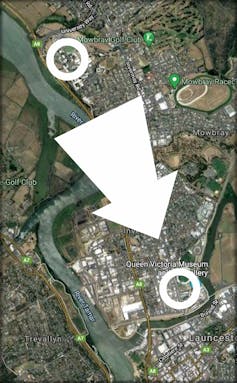
It has many similarities to the Perth city deal, not the least being the university will have to do most of the heavy lifting, including bearing the risk of cost overruns.
There are rosy projections that the new site will attract more students, including internationals, but they run counter to the experience of the university’s School of Architecture and Design, which has experienced a catastrophic decline in enrolments despite being at Inveresk for many years.
In another part of the “Northern Transformation” project, the University of Tasmania is moving its Burnie operation from a 25-year-old campus at Mooreville Road 2 km to a new $85 million campus at West Park.
All up, the Northern Transformation project will cost the University of Tasmania more than $300 million, which at the moment it does not have.
Darwin is getting yet another CBD campus
A similar story is playing out in Darwin, where a new CBD campus for Charles Darwin University is being delivered 14 km from its main campus at Casuarina.
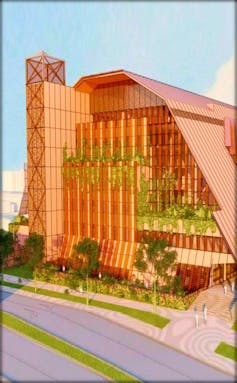
There the aim is to create an iconic building “that links city-based elements of CDU to each other and to various parts of the city, and offers the potential to reimagine the CBD with the university at its heart”.
What’s odd is that Charles Darwin University already has a CBD campus, organised in a deal with a local developer. It hasn’t met its student growth targets, mainly because it lacks the things needed to attract students, including a decent library, cheap places to eat and affordable accommodation.
The new CBD campus will be better than that, but the vastly more efficient option of simply redeveloping the main Casuarina campus and dumping the failed existing city campus wasn’t on the table.
While the Darwin CBD campus will generate jobs during construction, and the territory government will be overjoyed to be getting some cranes back on the Darwin skyline, the benefit for the university is harder to identify.
Funding ought to be needs-based
I am not against funding university redevelopments, far from it. Many of Australia’s university buildings are old and in need of updating.
The University of Tasmania, Charles Darwin University, Edith Cowan University and Western Sydney University, among others, enrol less of the international students that have allowed other universities to fund the maintenance and redevelopment of their buildings. Charles Darwin University and the University of Tasmania are the only universities in their states.
But the City Deal process is forcing universities to move into CBDs to get funds, whether it makes sense or not.
Read more: Why is the Australian government letting universities suffer?
Evidence suggests that CBD campuses are a fad, not a solution. Campuses in tall buildings cost about twice as much per delivered square metre as low to medium rise sites and CBD buildings lack the long-term development flexibility of a campus.
Most importantly, undergraduate students don’t much like them. They lack parking spaces, they often lack child-care facilities, students are forced to cram into lifts to move between classes, and they are not near cheap accommodation.
Students prefer space to height
The campuses popular with students around the world tend to be about 5-10 km from a CBD and have 5,000 to 20,000 students, with a high proportion living on campus.
Bond, the University of New England and Griffith University are good Australian examples. Leiden, Bath, Lancaster and Stanford are overseas examples.
It is sometimes said CBDs attract students, particularly international students, but most of Australia’s biggest and most successful universities are located on the city fringe or in suburbs.
Read more: 3 ways the coronavirus outbreak will affect international students and how unis can help
Few successful research universities are located in the centre of cities. Of the top 100 research universities in the world, as measured by the Academic Ranking of World Universities, only a handful are in CBDs, and usually only because the CBD engulfed them.
The best research comes out of large campuses, rather than single buildings.
The best-value university projects ought to be the ones that get funded rather than those that have the side benefit of allowing politicians to (repeatedly) claim they are “revitalising” cities.
But that would require paying attention to universities for their own sake, something the government appears reluctant to do.![]()
Geoff Hanmer, Adjunct Professor of Architecture
This article is republished from The Conversation under a Creative Commons license. Read the original article.
Poor ventilation may be adding to nursing homes' COVID-19 risks
Geoff Hanmer and Bruce Milthorpe, University of Technology SydneyOver 2,000 active cases of COVID-19 and 245 resident deaths as of August 19 have been linked to aged care homes in Victoria, spread across over 120 facilities. The St Basil’s cluster alone now involves 191 cases. In New South Wales, 37 residents were infected at Newmarch House, leading to 17 deaths.
Why are so many aged care residents and staff becoming infected with COVID-19? New research suggests poor ventilation may be one of the factors. RMIT researchers are finding levels of carbon dioxide in some nursing homes that are more than three times the recommended level, which points to poor ventilation.
An examination of the design of Newmarch in Sydney and St Basil’s in Melbourne shows residents’ rooms are arranged on both sides of a wide central corridor.
The corridors need to be wide enough for beds to be wheeled in and out of rooms, but this means they enclose a large volume of air. Windows in the residents’ rooms only indirectly ventilate this large interior space. In addition, the wide corridors encourage socialising.
If the windows to residents’ rooms are shut or nearly shut in winter, these buildings are likely to have very low levels of ventilation, which may contribute to the spread of COVID-19. If anyone in the building is infected, the risk of cross-infection may be significant even if personal protective equipment protocols are followed and surfaces are cleaned regularly.
Why does ventilation matter?
Scientists now suspect the virus that causes COVID-19 can be transmitted as an aerosol as well as by droplets. Airborne transmission means poor ventilation is likely to contribute to infections.
A recent article in the journal Nature outlines the state of research:
Converging lines of evidence indicate that SARS-CoV-2, the coronavirus responsible for the COVID-19 pandemic, can pass from person to person in tiny droplets called aerosols that waft through the air and accumulate over time. After months of debate about whether people can transmit the virus through exhaled air, there is growing concern among scientists about this transmission route.
Read more: Is the airborne route a major source of coronavirus transmission?
Under the National Construction Code (NCC), a building can be either “naturally ventilated” or “mechanically ventilated”.
Natural ventilation requires only that ventilation openings, usually the openable portion of windows, must achieve a set percentage of the floor area. It does not require windows to be open, or even mandate the minimum openable area, or any other measures that would ensure effective ventilation. Air quality tests are not required before or after occupation for a naturally ventilated building.
Nearly all aged care homes are designed to be naturally ventilated with openable windows to each room. In winter most windows are shut to keep residents warm and reduce drafts. This reduces heating costs, so operators have a possible incentive to keep ventilation rates down.
From inspection, many areas of typical nursing homes, including corridors and large common spaces, are not directly ventilated or are very poorly ventilated. The odour sometimes associated with nursing homes, which is a concern for residents and their visitors, is probably linked to poor ventilation.
Carbon dioxide levels sound a warning
Carbon dioxide levels in a building are a close proxy for the effectiveness of ventilation because people breathe out CO₂. The National Construction Code mandates CO₂ levels of less than 850 parts per million (ppm) in the air inside a building averaged over eight hours. A well-ventilated room will be 800ppm or less – 600ppm is regarded as a best practice target. Outside air is just over 400ppm
An RMIT team led by Professor Priya Rajagopalan is researching air quality in Victorian aged care homes. She has provided preliminary data showing peaks of up to 2,000ppm in common areas of some aged care homes.
This figure indicates very poor ventilation. It’s more than twice the maximum permitted by the building code and more than three times the level of best practice.
Research from Europe also indicates ventilation in aged care homes is poor.
Good ventilation has been associated with reduced transmission of pathogens. In 2019, researchers in Taiwan linked a tuberculosis outbreak at a Taipei University with internal CO₂ levels of 3,000ppm. Improving ventilation to reduce CO₂ to 600ppm stopped the outbreak.
Read more: How to use ventilation and air filtration to prevent the spread of coronavirus indoors
What can homes do to improve ventilation?
Nursing home operators can take simple steps to achieve adequate ventilation. An air quality detector that can reliably measure CO₂ levels costs about A$200.
If levels in an area are significantly above 600ppm over five to ten minutes, there would be a strong case to improve ventilation. At levels over 1,000ppm the need to improve ventilation would be urgent.
Most nursing homes are heated by reverse-cycle split-system air conditioners or warm air heating systems. The vast majority of these units do not introduce fresh air into the spaces they serve.
The first step should be to open windows as much as possible – even though this may make maintaining a comfortable temperature more difficult.
Read more: Open windows to help stop the spread of coronavirus, advises architectural engineer
Creating a flow of warmed and filtered fresh air from central corridor spaces into rooms and out through windows would be ideal, but would probably require investment in mechanical ventilation.
Temporary solutions could include:
industrial heating fans and flexible ventilation duct from an open window discharging into the central corridor spaces
radiant heaters in rooms, instead of recirculating heat pump air conditioners, and windows opened far enough to lower CO₂ levels consistently below 850ppm in rooms and corridors.
The same type of advice applies to any naturally ventilated buildings, including schools, restaurants, pubs, clubs and small shops. The operators of these venues should ensure ventilation is good and be aware that many air-conditioning and heating units do not introduce fresh air.
People walking into venues might want to turn around and walk out if their nose tells them ventilation is inadequate. We have a highly developed sense of smell for many reasons, and avoiding badly ventilated spaces is one of them.![]()
Geoff Hanmer, Adjunct Professor of Architecture and Bruce Milthorpe, Emeritus Professor, Faculty of Science, University of Technology Sydney
This article is republished from The Conversation under a Creative Commons license. Read the original article.
If architecture is the canary in the coalmine, the outlook for construction is appalling

Architecture suffers before building does.
A survey of more than 450 architecture practices conducted by the Association of Consulting Architects finds that two thirds have lost more than 30% of their revenue, and eight in ten have had projects cancelled or put on hold.
Six in ten are relying on JobKeeper. Half have cut pay or working hours. Three in ten have stood down or sacked staff. Only 15% believe they have enough work to see out the year.
In total, the survey finds more than A$10 billion of projects have either been cancelled or put on hold, just among those responding to the survey.
John Held, the National President of the Association of Consulting Architects says
unless there is a more effective stimulus package for construction, the government will need to consider extending JobKeeper beyond its expiry in September to prevent the loss of many normally-viable architectural practices. Without a pipeline of projects, a substantial rise in unemployment across the whole construction sector will result
Dr Peter Raisbeck, an expert in the building and construction industry at the University of Melbourne, says
two thirds of architects in Australia are small businesses employing less than five people, operating on small profit margins. Widespread insolvencies amongst these vulnerable firms would be catastrophic
The design professions – architecture and engineering – are the canary in the coalmine for the wider construction industry. If those professions are in a slump now, construction itself will most probably be in big trouble in three to six months.
A window on the future
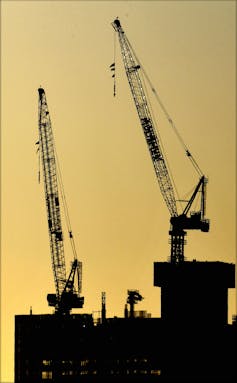
The findings are reinforced by forecasts prepared by the Australian Construction Industry Forum.
They show that while engineering construction on projects such as motorways and public transport is likely to hold up reasonably well, residential and non residential construction, already weak prior to COVID-19, is set to slump over this year and the next, with the brunt of the impact being felt in NSW and Victoria.
It will be very bad for employment.
The building and construction industry consists of nearly 400,000 businesses that directly employ more than 1.2 million Australians. Most of the supply chain for building materials is in Australia, particularly for low-rise residential buildings.
The immediate priority should be to ensure that projects continue to be designed and documented to avoid the “valley of death” caused by the need for drawings to be completed before construction can start.
We’ve had warning
If eight out of ten architectural practices have projects that have been cancelled or put on hold now, there will be a significant shortage of projects going to tender later in 2020 and in 2021.
Based on the numbers in the surveys, the loss of jobs in construction could add two percentage points to unemployment during 2021.
To overcome the valley of death, something needs to be done to restart projects that have been deferred or cancelled.
To their credit, state and territory governments have brought forward varying amounts of public works projects, including schools, hospitals and a small amount of social housing. In Victoria, the acceleration of the government’s combustible cladding replacement program is also helping to prop up demand.
Unfortunately, the evidence from the Association of Consulting Architects survey suggests this won’t be enough.
Read more: HomeBuilder might be the most-complex least-equitable construction jobs program ever devised
HomeBuilder, the federal government’s $680 million program intended to “save the tradies”, appears to have stalled.
So far, none of the states has finalised an implementation plan for the scheme, perhaps because it was so poorly designed.
In Sydney, where a lot of houses may exceed the $1.5 million value cap, some builders are complaining that the scheme is actually delaying decisions while homeowners wait to see if it will apply to them.
And we know what to do
We can learn from history. The Rudd government’s $3 billion (in today’s money) Building the Education Revolution scheme was successful in stimulating construction and delivering jobs during the global financial crisis.
The $3 billion Home Insulation Program (later known as the “pink batts” program) also created jobs.
Although there was widespread and justified criticism of how both programs were implemented, they were big enough and quick enough to make a difference to employment. And they delivered general benefits.
We should be able to learn from these ideas and the mistakes that were made in their implementation.
Read more: What'll happen when the money's snatched back? Our looming coronavirus support cliff
The Morrison government’s efforts to support the construction industry to date have been too small and too slow. The architects survey suggests the design professions will go over a cliff in September. The construction forecast suggests that the construction industry will follow them over in 2021.
State and local governments have a long list of useful school, health and community projects that could go ahead now if the federal government made the money available.
Many shovel-ready projects that have been cancelled are in the higher education sector, many of them meant to deliver the STEM graduates or STEM research that the government says it is keen on.
There is also a crying need for good social housing, made more apparent by developments in Melbourne.
If we learned anything from the global financial crisis, it was that going hard and early worked. It is not too late to do it now, but it will be soon.![]()
Geoff Hanmer, Adjunct Professor of Architecture
This article is republished from The Conversation under a Creative Commons license. Read the original article.
HomeBuilder might be the most-complex least-equitable construction jobs program ever devised

HomeBuilder is a good idea gone bad. It is possibly the most complex and least equitable program the government could have devised to deliver construction jobs.
It gives $25,000 to people who already own a home or already have enough money to buy one while delivering a minimal stimulus to extra construction. It isn’t a program to create jobs, it is a way of making people who are reasonably well off richer.
It does not address homelessness, precarious rental or any of the other pressing problems that are caused by our current housing mix.
It might build more nice decks for sipping Chardonnay (most already planned), it might deliver ritzy new bathrooms with imported taps or even new kitchens with the latest European appliances, but it won’t help those suffering housing stress.
Read more: Scott Morrison’s HomeBuilder scheme is classic retail politics but lousy economics
Construction is Australia’s third-biggest employer, after retail and health care and social assistance. It employs one in every 11 Australians, and it generates other jobs in the building supplies industry and in design and engineering.
The Master Builders Association says construction is facing a decline of 40%, with potentially horrendous implications for employment.
The industry has three main components:
residential – apartments and houses
commercial – including offices, airport terminals, retail, tourism, education and factories
engineering – including roads, railways and airport runways.
Engineering construction is doing reasonably well.
Across the country, governments are delivering a veritable infrastructure Utopia. Continuing projects include the Tullamarine Airport Rail Link, the second stage of the Sydney Metro, the North East Link motorway in Melbourne, the WestConnex motorway in Sydney, the Airport Metro in Perth and Cross River Rail in Brisbane.
All governments have to do is keep this pipeline going, which, by and large, they are doing.
On the other hand, commercial construction will be in deep trouble by the end of the year as current projects finish without new projects to replace them.
Outlook bleak, then COVID
The outlook for residential construction is desolate, although for some people with secure jobs working from home, COVID-19 appears to have ignited a mini home renovation boom.
Prior to COVID-19, commercial construction was forecast to shrink from A$48.77 billion in 2020-11 to $41.3 billion in 2023-24.
Residential construction was forecast to bottom out in 2021-22 with only 168,000 dwelling starts, down from a peak of 233,872 starts in 2016-17.
Now, both forecasts will be slashed.
The tourism sector is dead, the education sector is near death and the multi-unit residential market, already badly impacted by confidence issues around construction quality, is in terrible shape with many projects on hold.
Not big enough, not broad enough
The HomeBuilder scheme is not big enough or broad enough to do much to reignite residential construction. To be useful for jobs, it would need to deliver an extra 60,000 housing starts.
Given the only people who will benefit from the grant will be those some way down the track to either buying or building, it is hard to guess what the additional outcome will be, but it would be surprising if the scheme generated much additional activity.
Even if the full budget allocation of the scheme is taken up, it would fund only about 25,000 projects. Many would have gone ahead anyway.
Among the peculiarities of HomeBuilder are that it won’t work in much of Sydney where many houses are likely to be valued above the $1.5 million limit and it won’t work in regional towns where the required spend will overcapitalise existing houses.
Complexities aplenty
It will encourage people to build in fridges, microwaves, coffee makers and washing machines (many of them tastefully European) to bump the contract price up above the $150,000 minimum.
It is a potential administrative nightmare for state governments that are already stretched administering existing emergency relief programs.
Who will establish that the value of an existing house is less than the $1.5 million upper limit? Will it be the value now in the middle of the COVID downturn or the value last year, or the value used to set local government rates?
Contracts are meant to be arms-length, but who will ensure the builder is not the cousin or the in-law of the owner, something that might be impossible to avoid in a small country town? If a garage is built on the side of a house, rather than as a separate structure, will it comply with the rules? And on and on and on.
Few extra homes
While these are legitimate questions, they ignore the big, central problem with the scheme: the opportunity to deliver a substantial program of social housing that would address real problems, including homelessness, has been missed.
And the government has done it in a way that will minimise the jobs created and maximise the wealth transfer to Australians who are relatively well off.
For a government that has mostly managed to do the right thing ever since COVID-19 hit, this has been a terrible policy clanger.
It will encourage everyone who cannot afford to buy a home, or who is homeless, to believe the government has forgotten them.
Geoff Hanmer, Adjunct Professor of Architecture, University of Adelaide
This article is republished from The Conversation under a Creative Commons license. Read the original article.
No big packed lectures allowed if we're to safely bring uni students back to campus
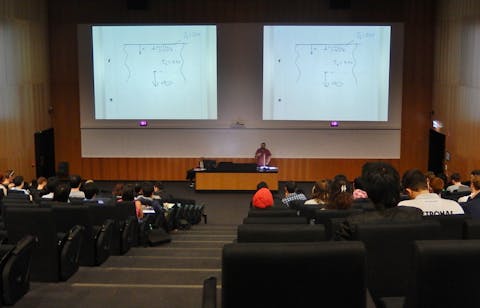
A return to face to face teaching at universities and technical colleges “where possible” is one of the goals of the Morrison government’s three step framework for a COVIDsafe Australia.
A look at the space available for teaching shows some return of students is possible.
But nearly all tiered lecture theatres will not comply with the social distancing rule of staying 1.5m apart, assuming they are seated at capacity. Those lectures will have to remain online or the rules around class sizes will need to change.
Back to the campus
Universities moved teaching operations off campus to cope with the COVID-19 pandemic. Many lectures and tutorials are now done online.

Universities have the challenge of working out how to safely get staff, students (and researchers) back to campus.
But the teaching space data from eight Australian universities reveals a number of problems in returning to campus while meeting social distancing rules. Some of these can be overcome, but others, including the key goal of increasing face to face teaching, will be much harder.
Until we reach Step 3, when up to 100 people may be permitted to gather in one space, opening up a campus is impractical. Under Steps 1 and 2 only 20 people are allowed in one space.
Come up to the lab
It should be possible to reestablish most laboratory based teaching and research to meet Step 3 guidelines without too many complications. The space data shows most laboratories provide about 4m² per person on average, although space between benches in some older labs may pose issues.
Where open plan offices are being used, they will have to meet social distancing rules.
Most university open plan offices have a density that is significantly lower than the 4m² average set by the guidelines, although achieving the 1.5m distancing rule may require some adaptations, such as additional screens.
Staff will be needed on campus as students return, but simple provisions similar to that used in retail shops, including floor signs and barriers, will be adequate to achieve the distancing guidelines. The continuing trend to move student services online will also help.
Cramped lecture rooms
Teaching space is much more problematic. The space data shows it is not possible to deliver conventional lectures in most existing tiered auditoriums during Step 3 restrictions. The absolute limit of 100 students in one space, narrow seat aisles and close seat spacing make them difficult to adapt.
Online lectures will still be necessary for the foreseeable future.
It is possible to deliver small group teaching, in groups of 19 to 100, but the space data we examined show only about one-third of non-lecture and non-laboratory teaching hours could be delivered on campus across a typical 50-hour week.
The smallest room that could accommodate a group of 19 students and an academic is 80m² under Step 3 guidelines. Only about 20% of campus teaching spaces are big enough although this percentage does vary from campus to campus.
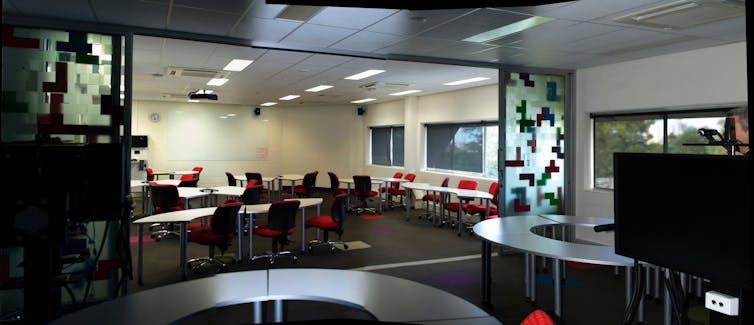
Successfully delivering small group teaching will probably require a lot of work on existing course structures and plenty of furniture relocation. But the opportunity to provide this type of teaching to the limit of capacity will be valuable in supporting retention and improving student experience.
Students love campus life
A campus is the largest capital investment a university makes and there are valid reasons why this is so. Attrition, retention and student experience data all suggest face to face teaching and other aspects of campus life are effective ways to attract, engage and retain undergraduate students.
A campus is also essential to deliver laboratory-based research. STEM research accounts for the majority of university research income and delivers many useful things, including perhaps a SARS-CoV-2 vaccine.
The timing of Step 3 is in the hands of state governments. For example, Queensland says it will move to Step 3 on July 10 while Tasmania has chosen July 13.
By the start of Semester 2 in late July or early August, it is probable that most states will have moved to Step 3.
UNSW, which moved to a three term model last year, will commence Term 2 on June 1, too early for Step 3.
Getting to campus
Another challenge though for universities is that of getting staff and students to campus on time. The capacity of public transport has been severely reduced by social distancing rules under Step 3.
Read more: Universities need to train lecturers in online delivery, or they risk students dropping out
In many cases it will not be practical to operate a campus with a full student or staff load.
Because campus populations are likely to be considerably reduced for a significant period of time, the challenges currently faced by on campus shops, food outlets and recreational facilities will continue.
The faint silver lining to all of this could be a long-term shift towards small group teaching, supplemented by high quality online materials, rather than reverting to the large lecture as we knew it.
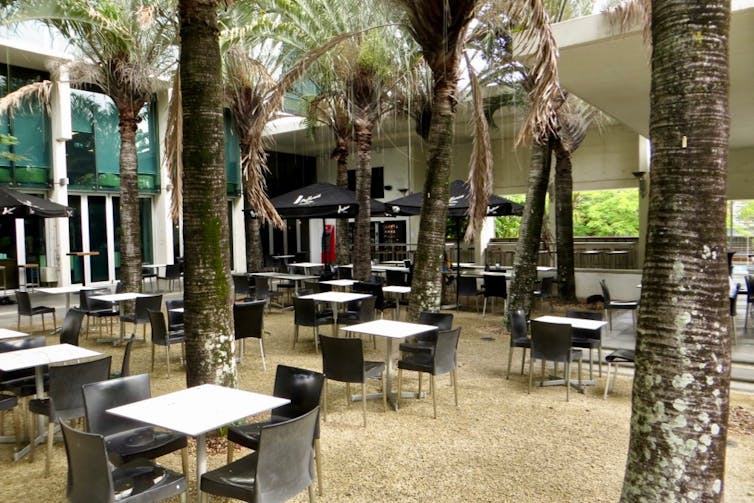
Geoff Hanmer, Adjunct Professor of Architecture, University of Adelaide
This article is republished from The Conversation under a Creative Commons license. Read the original article.
Why the focus of stimulus plans has to be construction that puts social housing first
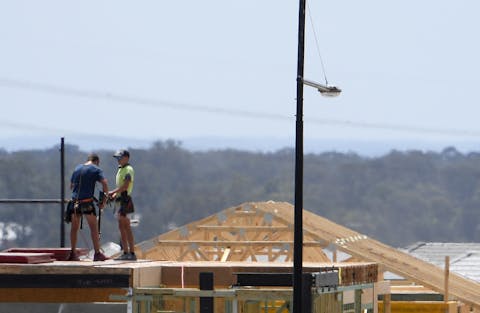
Australia has done better with COVID-19 than anyone dared hope. This opens up the prospect of a progressive relaxation of restrictions later this year. Organisations that could participate in an economic stimulus program will need to be in a position then to deliver “shovel-ready” projects to help revive the economy.
The construction sector is the obvious focus of a stimulus plan, and the construction of social housing should be the priority, for reasons that I’ll outline below.
Read more: Is social housing essential infrastructure? How we think about it does matter
The Rudd government’s stimulus package during the Global Financial Crisis gives us a helpful guide to what does and doesn’t work. The initiatives that failed did so because of a lack of proper planning.
Fortunately, if we get going now, we have months to plan the recovery program. Getting it right will be crucial. By September, one month before JobKeeper payments end, many businesses are going to be on their knees.
Why construction?
Most of the successful elements of the Rudd package focused on construction. The reason is simple. Nearly one in ten Australians work in the construction industry. Many more are employed locally in the production of building products.
Both construction and building product manufacturing provide jobs for people with varying levels of skill, including people who are unskilled. The vast majority of concrete and steel reinforcement, bricks, wall framing, building boards, windows and doors, roof tiles and metal cladding are still made here. A substantial portion of domestic electrical and plumbing products, including stainless steel sinks, copper pipes and electrical cables are also made here.
It’s important to realise that the type of building being constructed will affect its local stimulatory impact. For buildings up to three storeys high, over 50% of their cost is labour on site. Of the remaining cost, the vast majority is Australian-made materials and components. (Although the Australian Bureau of Statistics stopped its series on Australian-made construction products in 2014, the employment impact can still be estimated from ABS manufacturing statistics.)
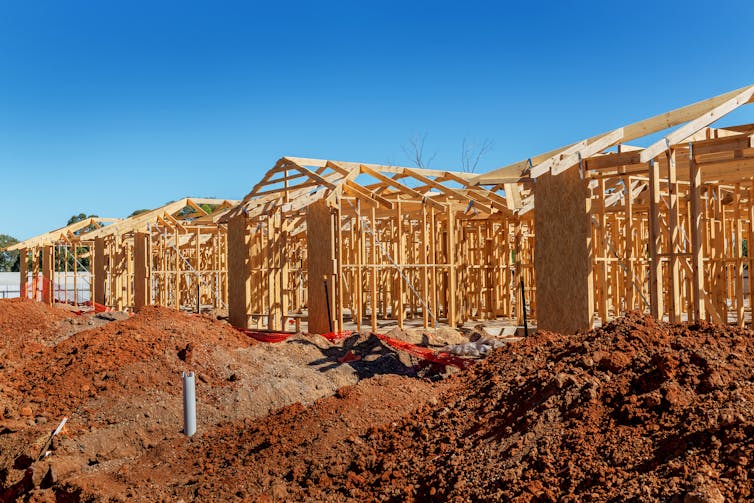
However, the taller a building gets, the greater the percentage of imported components – lifts, mechanical components and facade systems are mostly imported.
Why social housing?
What sort of construction projects should the government consider for a stimulus package? While the response so far has been to focus on “fast-tracking” infrastructure, the current crisis has highlighted a number of pressing social needs. Various aspects of social housing top the list:
Housing to reduce the number of people living in precarious private rentals. A substantial program to increase the stock of social housing would be a great legacy.
Housing for people who are homeless. They will not be able to go on living in hotels once the lockdown ends.
Affordable housing for workers in health, emergency services, education and retail who cannot afford to live close to the communities they provide vital support to. It turns out they are essential workers, some of the most important people in Australia, so we need to look after them.
Housing construction is a very effective way to create jobs, both directly and downstream. About 6% of Australian jobs are related to housing.
What other construction work is needed?
There are other opportunities for well-targeted construction stimulus.
In many areas of Australia, public schools and kindergartens still rely on low-quality portable buildings or buildings that have exceeded their economic life. A program to replace them with new and efficient buildings would produce substantial social benefits, cut maintenance costs and improve sustainability.
Improving the deteriorated state of community buildings and parks, particularly in disadvantaged areas, would also deliver social benefits and potentially employ a lot of unskilled labour. Having decent parks and exercise facilities close to where people live will allow social distancing to continue as long as needed.
A Victorian government plan to remove combustible cladding from residential and community buildings could also be extended to all states. It’s essential work that would also create jobs.
Read more: Flammable cladding costs could approach billions for building owners if authorities dither
The government could also consider a program to replace or refurbish university teaching and research buildings that are over 40 years old. Incredibly, as we have found at ARINA in our consultancy work, these older buildings still provide more than half of the 11.8 million square metres of gross floor space occupied by the higher education sector.
These ageing buildings are not well suited to supporting the research into solutions to SARS-CoV-2 and other pressing medical and economic problems. Replacing or refurbishing them would improve outputs, cut maintenance costs and improve sustainability, plus give a much-needed boost to the higher education sector.
Plan now to be shovel-ready
Anglicare SA is already thinking of what it can do to deliver more social housing. Its CEO, Peter Sandeman, told me he is making sure Anglicare has “shovel-ready projects that can be rolled out the moment a stimulus package is announced. There is no better way of stimulating the economy than by constructing social housing.”
This is stimulus that also meets critical social needs, Sandeman says.
There is a desperate shortage of social housing. Our waiting list and the number of people who are homeless demonstrates that.
Social housing provides a long-term benefit to everyone. It adds stability to the lives of the occupants and this is a particular benefit to their children and their education. Safe, affordable housing is the foundation stone that gives people a chance in life.
Other organisations that could be part of the stimulus package should be getting ready, too, and making sure the government knows what they are doing.
Read more:
Australia's housing system needs a big shake-up: here's how we can crack this
![]()
Geoff Hanmer, Adjunct Professor of Architecture, University of Adelaide
This article is republished from The Conversation under a Creative Commons license. Read the original article.
Automatic doors: the simple technology that could help stop coronavirus spreading

New research in the New England Journal of Medicine suggests that SARS CoV 2, which causes the disease known as COVID-19 coronavirus, is more stable on plastic and stainless steel than on cardboard or copper:
The longest viability of both viruses was on stainless steel and plastic; the estimated median half-life of SARS-CoV-2 was approximately 5.6 hours on stainless steel and 6.8 hours on plastic"
This is disquieting news for building designers and the manufacturers of door hardware and taps, who have traditionally used stainless steel or chromed brass under the common (but incorrect) impression that they provide an unfriendly environment for bacteria and viruses.
They are certainly relatively easy to clean, at least visually, but taps and door pulls in public toilets and door hardware in apartment common spaces and lift buttons are not cleaned between every use.
With this in mind, it is concerning to see just how many doctor’s surgeries and dedicated coronavirus facilities in Australia and elsewhere still appear to be equipped with manual hinged doors with stainless steel or chromed brass handles and push plates, both inside and out.
Doctor’s surgeries have door handles
It is clear from the available research that this type of touch point poses a risk of transmission, particularly in placers where a significant proportion of users will be ill with a virus, if not SARS CoV 2.
Door handles, door pushes, lift buttons, flush buttons, taps and hand dryer buttons are all typically made from hard materials including stainless steel and plastic.
While SARS CoV 2 is a uniquely hazardous bug, other common viruses and bacteria, including the common cold and the rotaviruses that cause gastro-intestinal infections are also transferred by touch points in buildings.
This is completely unnecessary given that we have simple technology available to obviate the problem.
Automatic doors are cheap and safe
While the lifts and reinforced concrete were probably the most significant technical developments for buildings in the nineteenth century, the development of a reliable automatic door was, alongside mechanical air conditioning, among the two most significant technical developments for buildings in the twentieth century.
Similarly, we now have reliable technology to automatically flush toilets, dispense hand wash and operate taps.
Even if we can’t afford an automatic door on the outer doors of public toilets, the least we can do is plan the doors to open outwards so the doors can be opened with our elbows, or eliminate the doors entirely by making the entrances U-shaped.
Our reluctance to install them is odd
In the current crisis, we ought to be consider propping open high-traffic doors in public buildings, retrofitting powered door openers or simply removing them. We can use keys, pens and elbows to operate lift buttons.
The fact that sliding automatic doors are not more widespread is odd. They are moderately priced by comparison with many other components of buildings and often more durable in high traffic areas than hinged doors.
They are also safer than hinged doors because they are unlikely to clobber people or crush fingers, and they are far friendlier to people with children and people carrying boxes of files or trays of donuts.
Some architects don’t like the look of them, but this is hardly a sufficient reason not to mandate them given their benefits.
Read more: To restore public confidence in apartments, rewrite Australia's building codes
It is astonishing that it is still possible under the National Construction Code to build medical facilities meant for people who are more likely than most to have infectious illnesses without mandating the use of automatic doors, automatic flushing devices, automatic taps and automatic handwash dispensers.
And it is hard to believe that the same rules should not be applied to all high traffic locations, such as common spaces in large apartments, airports, bus stations and train stations.
And there’s a problem with air conditioners
A related problem highlighted in the new research is that SARS CoV 2 appears to be able to continue to live in the air. The time it took for half of the virus particles to become inactive was just over an hour. If the research is correct, airborne transmission is possible.
Many air conditioning systems recirculate air throughout a floor or a whole building, typically at around eight air changes per hour.
Research from Purdue Universityand the National Centre for Infectious Diseases in Singapore suggests that recirculating air conditioning systems could spread SARS CoV 2, although we are not sure how likely it is.
Some air conditioning systems, including in parts of some hospitals, are equipped with High Efficiency Particulate Air (HEPA) filters which appear to be effective in capturing SARS CoV 2, even though it is about three times smaller than the smallest opening in a HEPA filter.
Most conventional air conditioning filters won’t do it.
Read more: Our buildings aren't made to keep out bushfire smoke. Here's what you can do
It might be wise to operate using recirculating air conditioning systems that lack HEPA filters in full fresh-air mode where this is possible, which is the case in many recently-built office buildings.
If people who may have the disease are confined in a building without openable windows, such as a hotel, those in the building could face problems. Most recent hotels have a system which confines recirculated air to one room and should be safe, but not all do.
Openable windows and natural ventilation are probably the safest option, providing a good reason for many of us to stay at home.
Domestic split system air conditioners, which simply recirculate air within one house, or systems that rely on 100% outside air, are safe, providing those of us in homes aren’t already infected.![]()
Geoff Hanmer, Adjunct Professor of Architecture, University of Adelaide
This article is republished from The Conversation under a Creative Commons license. Read the original article.
NSW building certification bill still lets developers off the hook
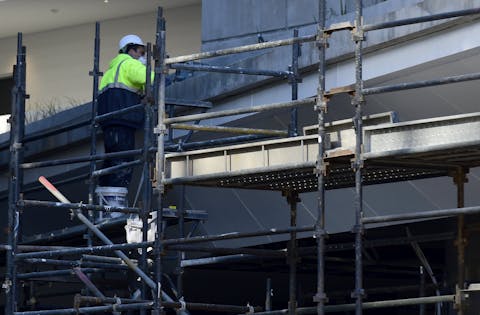
The News South Wales government is struggling to implement building industry reforms recommended by the Shergold-Weir report over two years ago.
Developers are home free in its proposed legislation; the Design and Building Practitioners Bill doesn’t even mention them. They still appear to be in a position to collect the profits and then phoenix themselves if something goes wrong.
And something is going wrong all too often. David Chandler, the NSW building commissioner appointed to oversee the reforms, said recently he was “ a bit despondent” after seeing “some really regrettable things out there” in a program of site visits.
Read more: Lack of information on apartment defects leaves whole market on shaky footings
Even though the commissioner can see how bad things are, he says it will take until 2022 for the building industry to “get people back to what they should be doing”.
The lack of progress hasn’t stopped the minister for better regulation, Kevin Anderson, claiming credit. In announcing the Design and Building Practitioners Bill 2019 last October, he said: “People should feel confident they can enter the housing market in NSW knowing their home has been designed and built in accordance with the Building Code of Australia.”
He must have forgotten to add “maybe after 2022” and “only if you are buying new”.
Read more: Would you buy a new apartment? Building confidence depends on ending the blame game
The upper house then rejected the bill. It’s now being revised.
What’s wrong with the bill?
The bill has the avowed aim of making people who design and build buildings responsible for non-compliance with the National Construction Code by getting them to sign certificates attesting that the building is built according to the code.
This is a guarantee of not very much. The code does not regulate durability or require that buildings be waterproof. Plus, of course, many people have been signing similar certificates for certifiers without it having had much impact to date.
The bill has many other faults and omissions. It does not require a principal design practitioner to be appointed to a complex project and no one is identified as the lead consultant. This means there is no person identified to coordinate design work between all disciplines (architecture and engineering) or to ensure design declarations relate to work as actually done, taking into account all engineering designs and site conditions.
The most critical problem is that the people signing the attestations are not required to actually inspect work during construction. Such a requirement was a key recommendation of the Shergold-Weir report.
The purpose of the bill, other than as political soft soap, is unclear. We already have design practitioners, called “architects”, who are registered under state law. We already have builders under state law, who are called “licensed contractors”.
We have the National Construction Code as a starting point for regulating building performance. We already have a Home Building Act. Under the Local Government Act, local councils clearly have the power to stop work on site if the builder is doing the wrong thing.
What we don’t have is a mechanism to unite these existing powers to ensure buildings are designed and documented to be durable, liveable and waterproof.
Read more: To restore public confidence in apartments, rewrite Australia's building codes
Steps that will solve the problems
If the government is as keen to deliver certainty to the new-build market as the minister asserts, what could it do?
First up, if there are things on site of the sort the building commissioner “abhors”, these sites should be shut down under existing powers. The state government would need to negotiate with councils about implementing and funding inspections, but this could be done promptly.
Does the government need to know which buildings to target? Simply look at the qualifications and track records of the building company directors.
A developer could be compelled to use a registered architect for any building for housing over two storeys high and required to retain the architect for site inspections during construction. Amendments to the Home Building Act or its regulations could achieve this.
As architects are already registered and legally required to hold professional indemnity insurance, no new legislation would be required. The lack of registration of engineers might be an issue, but no architect who is ultimately responsible for a building will work with an engineer they regard as incompetent.
The National Construction Code is not good at requiring buildings to be waterproof, but, again, some simple changes could be made to the Home Building Act. These should include beefed-up requirements for waterproofing any balcony or planter box larger in area than about six square metres.
We know for sure any tiles directly stuck to a membrane over a large area will fail, either immediately or relatively soon. Making it compulsory to use a system that allows tiles to be removed to access the membrane is simple and will eliminate years of misery.
What’s stopping the government?
If these steps are so simple and obvious, why isn’t the NSW government doing it?
Mainly, it would appear, because it’s in thrall to the development industry, which believes reintroducing these measures will reduce its profits.
The developers are right about this; building properly is more expensive. But I think most buyers would happily pay a bit more for a safe and durable product. They do that when buying consumer durables such as cars and appliances.
Good developers would benefit as this approach would help weed out the dodgy ones.
To restore the public’s lost confidence in new multi-unit residential housing, the government should pull the levers it has to hand first and then resolve the problem of existing defective stock.
Later it can think about some of the wider issues, but how about doing something useful now? We have been waiting two years.![]()
Geoff Hanmer, Adjunct Lecturer in Architecture, UNSW
This article is republished from The Conversation under a Creative Commons license. Read the original article.
Building standards give us false hope. There's no such thing as a fireproof house

Bushfires have killed 33 people and destroyed nearly 3,000 houses across Australia so far this fire season. Canberra is under threat right now.
It isn’t only houses. Significant commercial buildings have been destroyed, among them Kangaroo Island’s iconic Southern Ocean Lodge.
In New South Wales alone, 140 schools have been hit. Many require extensive work.
The National Construction Code provides false, and dangerous, hope.
It requires new homes (Class 1 buildings) built in declared “bushfire-prone” areas to be built to either Australian Standard 3959, the National Association of Steelframed Housing standard “Steel Framed Construction in Bushfire Areas”, or a “performance solution”, which could be anything that in the opinion of a qualified person complies with the performance requirements of the code.
It also applies to Class 2 buildings (apartments) and Class 3 buildings (hotels and guesthouses) in bushfire-prone areas.
Disturbingly, the code does not apply to community buildings, such as schools.
The standard does not fireproof buildings
The definition of “bushfire-prone” varies from state to state, as do the procedures for enforcing it.
Confused? So are many construction professionals.
The sad truth is that any practical building that is exposed to an intense bushfire will probably burn down, whether it complies with Australian Standard 3959 or not.
Worse still, the available evidence suggests there is a significant risk that the people sheltering in it will not survive without an effective refuge, which Australian Standard 3959 does not mandate or consider.
The standard speaks for itself:
Although this Standard is designed to improve the performance of buildings when subjected to bushfire attack in designated bushfire-prone areas, there can be no guarantee that a building will survive a bushfire event on every occasion. This is substantially due to the unpredictable nature and behaviour of fire and extreme weather conditions.
More importantly, while a building constructed to Australian Standard 3959 might be less likely to burn down, Standard 3959 in its current form might not protect the people within the building.
Worse, it might not protect people
The highest aim of any system of building regulation ought to be life and safety, followed by the protection of adjoining properties and then, a long way back, by the protection of the property itself.
In the case of bushfire, the Australian Building Codes Board and its political masters appear to have put the protection of buildings first, when it should be last.
If a house is under threat by bushfire, the best advice is to evacuate early, whether it complies with Australian Standard 3959 or not.
Read more: Our buildings aren't made to keep out bushfire smoke. Here's what you can do
By encouraging people to believe they can defend a structure compliant with Australian Standard 3959 we could be putting more people at risk than if we simply told them to evacuate.
Residents and firefighters defending houses have accounted for a large percentage of the deaths this fire season.
It’d be better to rethink where we build
We may need to have difficult conversations about whether our subdivision practices are appropriate. Allowing people to build in areas that are bushfire-prone, particularly where buildings are effectively built into the bush, might be creating unmanageable problems for the future.
If there is no such thing as a bushfire-proof house, as Australian Standard 3959 seems to concede, we might need to focus on evacuation and shelters.
In the United States, rather than requiring houses to resist tornadoes or wildfires, the Federal Emergency Management Agency encourages the provision of shelters. State and local authorities often make these mandatory.
People are more important than structures
Having attended one funeral for a person killed defending their home this fire season, I have had enough. We should not be worrying about protecting buildings until we have worked out how to protect human life.
The Building Ministers’ Forum and the Australian Building Codes Board should either embrace a policy of early evacuation or mandate fire shelters in bushfire-prone areas for both new and existing houses.
Read more: Australian building codes don't expect houses to be fire-proof – and that's by design
The board and the states should also make every effort to regulate to ensure all buildings and places designated as refuges of last resort can properly fulfil their intended function, whether they are new or not.
If we are going to have another fire season similar to this year, and so far the CSIRO predictions on this have been totally accurate, we will need to sort this out quickly, preferably before next summer.![]()
Geoff Hanmer, Adjunct Lecturer in Architecture, UNSW
This article is republished from The Conversation under a Creative Commons license. Read the original article.
Our buildings aren't made to keep out bushfire smoke. Here's what you can do

In early December 2019, a Sheffield Shield cricket match between NSW and Queensland was played in bushfire smoke so thick that the ball was at times invisible to the spectators.
Since then, the rest of us have become far more aware of the hazards of bushfire smoke, and authorities have become more active in reminding us how dangerous it can be, especially during exercise. A standard piece of advice is to “spend more time indoors”.
But does it work?
Up until this year, with bushfire smoke lasting only a few days, it was good advice, especially for buildings that rely on recirculated and filtered mechanical ventilation complying with Australian Standard 1668 Part 2.
These buildings include shopping malls, cinemas, hospitals, larger offices and some of the buildings in some universities.
It’s fine in cinemas, for a while…
Unfortunately, if smoke is particularly thick or goes on for more than a few days, these systems get overwhelmed, which is why smoke detectors in many commercial and institutional buildings have been setting off fire alarms and why the National Gallery of Australia in Canberra was closed on Sunday and Monday.
Most houses or apartments are designed to be “naturally ventilated” under the National Construction Code, which means every habitable room has an openable window or a vent.
Closing the windows, vents and doors will reduce the “air change rate”, which is the number of times an hour the air in the room is replaced by outside air.
Less fine in homes
Regrettably, unless there is no wind, CSIRO research suggests most Australian houses are quite leaky by international standards, mainly because of leaky windows and doors.

Houses and apartments built before 1970 are the worst. Many have fixed ventilators just below the ceiling level, a hangover from regulations designed to ensure gas lighting did not cause asphyxiation.
These ventilators are now unnecessary and can be safely blocked off.
In normal times some leakage is not a bad thing, as it offers protection against internal air pollution from volatile organic compounds in furniture and building materials and cooking, smoking and heating.
But these are not normal times.
The length and severity of bushfire smoke appears to be unprecedented.
With bushfire smoke persisting for days or weeks, the standard advice to be “indoors” is less effective. While houses and apartments might be useful for keeping smoke out for a few days or so, they become less effective over time, depending on how leaky they are.
Take care
Before embarking on a campaign to seal leaks with draft stripping and duct tape, please ensure your that your range hood is vented directly to outside (preferably with an automatic flap) that if you smoke you do it outside, and that your furniture and fabrics are low in volatile organic compounds, which arechemicals that release vapor at room temperature.
If your house is sealed up, do not use a gas cooker without an externally vented range hood or use an unflued gas heater at any time.
Ensure your vacuum cleaner has a HEPA (high-efficiency particulate air) filter.
Remember duct tape or masking tape is likely to be very difficult to remove if you leave it on for more than a few days and may damage painted surfaces.
Air conditioners aren’t much help
Even if your house is well sealed, it’s likely the air in it will become similar in quality to the air outside over a period of several days. While the air change rate in your house might be low, it will not be zero.
A recirculating air conditioner, such as a split system, will make you cooler but most domestic air conditioning filters are not capable of removing the very small particles in bushfire smoke – the ones that most make it dangerous.
Evaporative air conditioners or window mounted air conditioners that draw air in from outside will actually make indoor conditions worse.
Some recirculating air purifier systems will remove bushfire smoke, but they can be expensive to buy and run.
Air purifiers can help, but they’re expensive
To be effective against bushfire smoke, the air purifier needs to be fitted with a HEPA filter.
The performance of many purifiers is less than stellar, but a CHOICE survey published just before Christmas is a useful starting point.
CHOICE is preparing a bigger test of more models which it will publish in March 2020.
It brought forward the test of six of them because of the fires.
Read more: From face masks to air purifiers: what actually works to protect us from bushfire smoke?
All six remove bushfire smoke particles with various degrees of efficiency, but their coverage area is limited. The Blueair 205 performed the best.
For people in an at-risk group, the use of an air purifier in a sealed-up house or apartment should help.
The only certain solution for someone suffering from smoke or concerned about its long-term impacts is to go to a building that has a recirculating HEPA filtered air conditioning system or move to a location where the air quality is better.![]()
Geoff Hanmer, Adjunct Lecturer in Architecture, UNSW
This article is republished from The Conversation under a Creative Commons license. Read the original article.
To restore public confidence in apartments, rewrite Australia's building codes

A prestige apartment building in Sydney built by a well-known developer is undergoing a second replacement of a terrace waterproof membrane five years after replacement of the first one, which had leaked from completion.
The second membrane almost certainly complied with the National Construction Code (NCC) and was certified as compliant; the first one might also have complied. Yet, for 15 years, owners and tenants living under the terraces have put up with mouldy walls, carpets and ceilings because the code does not adequately control waterproofing materials and methods.
A key assumption made by governments and regulators has been that confidence will return to the market if apartments are built to meet National Construction Code requirements. As the story above shows, complying with the code alone will not be enough to fix many common defects. Public confidence will still be lacking.
Read more: Lack of information on apartment defects leaves whole market on shaky footings
In 2017, the Building Ministers’ Forum, the group of federal, state and territory ministers responsible for building regulation in Australia, commissioned a report from Peter Shergold and Bronwyn Weir. Their report said there was “… diminishing public confidence that the building and construction industry can deliver compliant, safe buildings which will perform to the expected standards over the long term”.
Since then, the high-profile structural failure and evacuation of Opal Tower on Christmas Eve 2018, the cladding fire at Neo200 in February 2019 and the structural failure and evacuation of Mascot Towers in June 2019 have kept this issue in the media spotlight. If anything, the public crisis of confidence has deepened.
Part of the problem is the code itself
The National Construction Code originated as a minimum standard to deliver structural integrity and fire safety. It was never intended to provide effective control over all the aspects of building work that make houses or apartments liveable and durable. This might come as a surprise to many people, including those in government, but it is inherent to the “minimum standard” approach that underpins the structure and objectives of the code.
The objectives on page 9 of volume 1 of the code, which covers apartments, are instructive:
1) ensure requirements have a rigorously tested rationale; and
2) effectively and proportionally address applicable issues; and
3) create benefits to society that outweigh costs; and
4) consider non-regulatory alternatives; and
5) consider the competitive effects of regulation; and
6) not be unnecessarily restrictive.
In attempting to consider “competitive effects”, avoid being “restrictive” and by encouraging “non-regulatory alternatives”, including self-certification and self-regulation, the code has opened the door to an “anything goes” mentality on many fronts.
Waterproofing requirements for houses and apartments under section F of the code are clearly ineffective, for a start.
The relevant Australian Standards, AS 4654.1 and AS 4654.2, were written with a lot of input from the building materials supply industry. The standards permit the use of unsuitable waterproofing membranes in many situations, particularly where ceramic tiles are directly bonded to an inappropriate liquid-applied membrane. As the example at the start of this article shows, this solution rarely lasts longer than four or five years and considerably less in some cases.
Rectification is expensive and inconvenient. It involves hacking up and replacing all the tiles.
In addition, every apartment building built without a step in the slab at the junction between walls and floors will probably develop leaks within a similar timeframe.
These practices are driven by the desire to save a few dollars in construction cost, not by a commitment to deliver a required standard of durability. Durability is not part of the code objectives.
Read more: Would you buy a new apartment? Building confidence depends on ending the blame game
How can the code be fixed?
We could improve the code in a number of simple ways:
Class 1 (houses) and class 2 (apartments) buildings should both be in volume 2, which would be dedicated to housing intended for sale. Houses and apartments should be required to be “fit for purpose” with a clearly stated objective to provide protection to the buyer. These should include a mandatory minimum statutory warranty of seven to ten years, backed by government.
The required durability of waterproofing membranes and details for all housing, and class 2 apartments in particular, must be clearly stated. Waterproofing should be required to last at least 25 years without significant maintenance, and perhaps 40 years for buildings where access to the waterproofing element requires demolition or is fundamentally difficult. Details that are not durable, including slabs without steps at wall junctions, or terrace and balcony tiles directly bonded to liquid-applied waterproof membranes, should be banned.
The structure of an apartment should be required to last with no substantial maintenance for at least 50 to 60 years. The minimum expectation for durability for any envelope component and associated finishes on buildings over three storeys should be 25 years, and perhaps 40 years for taller buildings.
The “performance requirements” of section F of the code, “Health and Amenity”, should be expanded to ensure apartments are comfortable, economical to maintain and sustainable.
Read more: Australia has a new National Construction Code, but it's still not good enough
Some developers are already delivering well-designed apartment buildings that are durable and fit for purpose. They are to be commended. The problem for buyers is identifying these amid a sea of dross.
For new houses and apartments, we need to ensure the National Construction Code matches community expectations on fitness for purpose and durability. This requires a return to more active and interventionist regulatory framework, including putting independent “eyes on the site” to inspect work during construction.![]()
Geoff Hanmer, Adjunct Lecturer in Architecture, UNSW
This article is republished from The Conversation under a Creative Commons license. Read the original article.
Would you buy a new apartment? Building confidence depends on ending the blame game

“What we need to do is rebuild confidence in Australia’s building and construction sector,” said federal minister Karen Andrews after the July 2019 meeting of the Building Ministers’ Forum.
This has been a recurring theme since the federal, state and territory ministers commissioned Peter Shergold and Bronwyn Weir in mid-2017 to assess the effectiveness of building and construction industry regulation across Australia. They presented their Building Confidence report to the ministers in February 2018.
In the 18 months since then, the combined might of nine governments has made scant progress towards implementing the report’s 24 simple recommendations. Confidence in building regulation and quality has clearly continued to deteriorate among the public and construction industry.
Read more: The big lesson from Opal Tower is that badly built apartments aren't only an issue for residents
In last week’s Four Corners program, Cracking Up, Weir was asked whether she would buy an apartment. She responded: “I wouldn’t buy a newly built apartment, no […] I’d buy an older one.” She went on to say:
We have hundreds of thousands of apartments that have been built across the country over the last two, three decades. Probably the prevalence of noncompliance has been particularly bad, I would say in the last say 15 to 20 years […] And that means there’s a lot of existing building stock that has defects in it […] There’ll be legacy issues for some time and I suspect there’ll be legacy issues that we’re not even fully aware of yet.
These comments may not have delighted those developers trying to sell new apartments, or owners selling existing apartments, but they are fair and correct. Confidence will not be restored until all the governments act together to improve regulatory oversight and deal with existing defective buildings.
Residents of the Lacrosse, Neo200, Opal and Mascot towers and other buildings with serious defects are already living with the impact of “legacy” problems. Over the weekend, another apartment building was evacuated – this time in Mordialloc in southeast Melbourne. The building was deemed unsafe because it was clad with combustible material and had defects in its fire detection and warning system.
Read more: Cladding fire risks have been known for years. Lives depend on acting now, with no more delays
A costly but essential fix
Fixing such defects is a costly business. A Victorian Civil and Administrative Tribunal decision established that the costs due to fire damage and replacing combustible cladding on the Lacrosse building in Melbourne are around A$36,000 per unit on average. At Mascot Towers, consultant engineers estimated the cost of structural repairs at up to A$150,000 per unit on average.
According to UNSW and Deakin research, between 70% and 97% of units in strata apartments have significant defects. Let’s assume 85% have such defects and the average cost of fixing these is only $25,000 per unit. That would mean total repair costs for the 500,000 or so tall apartments (four-storey and above) across Australia could exceed A$10 billion.
The Victorian government has taken the lead on combustible cladding, setting up and funding a A$600 million scheme to replace it. It’s also replacing combustible cladding on low-rise school buildings even though these may comply with the letter of the National Construction Code.
No other state has yet followed this lead. This is concerning given the risk to life. No one viewing images of the Neo200 fire in the Melbourne CBD could doubt how dangerous combustible cladding can be.
The other states and territories should immediately copy the Victorian scheme. While not perfect, and probably underfunded, it is a positive step to improve public safety. The Andrews government should be congratulated for doing something practical while its counterparts in New South Wales and Queensland, which have many buildings with combustible cladding, fiddle about.
Read more: Flammable cladding costs could approach billions for building owners if authorities dither
All governments share responsibility
The federal government’s response has been inadequate. When asked about contributing to the Victorian scheme, Karen Andrews said:
The Commonwealth is not an ATM for the states […] this problem is of the states’ making and they need to step up and fix the problem and dig into their own pockets.
This flies in the face of reality. All nine governments are responsible for building regulation and enforcement. All signed the intergovernmental agreement on building regulation.
The federal government, which chairs the Building Ministers’ Forum, leads building regulation in Australia. The Australian Building Codes Board, which produces the National Construction Code, is effectively a federal government agency. The precursor to the national code, the Building Code of Australia, was a federal initiative.
It is clear Australian governments have worked effectively together in the past to combat threats to life and safety, or to provide consumer protection nationwide. Examples include initiatives as diverse as the national gun buyback, the creation of the Australian Securities and Investment Commission (ASIC) and the program to replace defective Takata airbags in cars.
The crop of building defects we see today are a direct result of negligent regulation by all nine governments over the past two decades. Clearly, they all have a legal and moral duty to coordinate and contribute to a program to manage the risks and economic damage this has created.
All the evidence points to a long-term failure to heed repeated warnings about the dangers. Governments and regulators were captive to the interests of the development lobby, building industry and building materials supply industry.
The governments must stop playing a blame game. Effective programs are urgently needed to fix defects, including combustible cladding, incorrectly installed fire protection measures, structural noncompliance, structural failure and leaks.
The Australian Building Codes Board, which is directly responsible for the mess, should be reformed to ensure it becomes an effective regulator. The National Construction Code should be changed to make consumer protection an objective in the delivery of housing for sale.
All parties involved will have to take some pain: regulators, developers, builders, subcontractors, consultants, certifiers, insurers, aluminium panel manufacturers, suppliers and owners. Only governments can broker a solution as it will require legislation and an allocation of responsibility for fault.
The alternative will probably be a huge number of individual legal cases and a rash of owner bankruptcies, which may well leave the guilty parties untouched.
This article has been updated to clarify the nature of around A$12 million in costs incurred by apartment owners in the Lacrosse building, of which A$5.6 million was the agreed cost of replacing combustible cladding after the 2014 cladding fire. These costs do not include legal costs or financial impacts on owners, such as reduced property values, that are unable to be assessed under the rules of the tribunal.![]()
Geoff Hanmer, Adjunct Lecturer in Architecture, UNSW
This article is republished from The Conversation under a Creative Commons license. Read the original article.
Ministers fiddle while buildings crack and burn

The Building Ministers’ Forum (BMF) met yesterday yet again to discuss implementing the February 2018 Shergold-Weir Report they commissioned in mid-2017. The BMF is responsible for overseeing the Australian Building Codes Board (ABCB) and building regulation across Australia. The BMF announced yesterday it’s going to “strengthen” the ABCB, which will be “expanded to include greater representation and engagement from industry”.
This is the same regulator and the same industry that have been responsible for producing the dud buildings that have been making news across the country: Lacrosse, Opal, Neo200, Mascot Towers, the Gadigal Avenue apartments and countless others that have burned, leaked, cracked and failed, but in less newsworthy ways.
Read more: Buck-passing on apartment building safety leaves residents at risk
On being appointed by the federal Coalition government in November 2017, the current chair of the ABCB, ex-NSW premier John Fahey, had this to say about his priorities:
The reform must reduce significantly red tape and have an over-riding focus of industry affordability.
In other words, the ABCB was to improve compliance by reducing red tape and focusing on “affordability”, which is about making buildings cheaper at completion. As the White Queen said to Alice in Wonderland: “Why sometimes I’ve believed as many as six impossible things before breakfast.”
Self-regulation has failed
Needless to say, virtually no progress has been made to re-regulate the industry, provide protection for consumers, or improve the durability and safety of buildings in the 19 months Fahey has held the reins.
Both major political parties have played a role in creating the policy and self-regulation regime that has produced so many faulty buildings over the last 30 years. It is about time the ALP, the Coalition, the BMF and the ABCB admitted that self-regulation has failed. NSW Liberal Premier Gladys Berejiklian has already done so:
We allowed the industry to self-regulate and it hasn’t worked. There are too many challenges, too many problems, and that’s why the government’s willing to legislate.
The building ministers should instruct the ABCB to dump its focus on self-regulation and also require the regulator to start taking into account whole-of-life building costs, not just cost at completion. Senior ABCB staff, including the chair, appear to be part of the problem. Asking for their resignation or sacking them would not be unreasonable in the circumstances.
Regulations are far from watertight
Section F of the National Construction Code (NCC), which controls waterproofing, should be immediately rewritten to make it clear buildings should be waterproof. Section FP1.4 now reads:
A roof and external wall (including openings around windows and doors) must prevent the penetration of water that could cause — (a) unhealthy or dangerous conditions, or loss of amenity for occupants; and (b) undue dampness or deterioration of building elements.
What are “unhealthy or dangerous conditions”? What constitutes a “loss of amenity”? What is “undue dampness”?
No one can answer these questions, which is why builders and developers regularly try to dodge responsibility for leaks, by claiming moisture ingress is due to occupants “taking too many showers” or that “a bit of moisture is normal”.
The ABCB should change this clause to read:
A roof and external wall including all penetrations and inclusions must prevent the ingress of water and water vapour to the habitable part of a building for a minimum period of 40 years, without any maintenance.
Specifying durability standards is important. At present, most of the test methods in the NCC are satisfied if a sample component performs once in a lab. This does not deal with issues that occur in practice.
We know that any joint depending entirely on a sealant or paint is likely to last for only between seven and ten years if it is exposed to typical Australian sunlight and atmospheric conditions. That is nowhere near good enough on a tall building, where the entire facade will have to be scaffolded to rectify defects.
Read more: Australia has a new National Construction Code, but it's still not good enough
Unfortunately, we can’t sack the past state and federal ministers who have presided over this fiasco. But the least the current politicians can do is not appoint them to the authorities that are supposed to be cleaning up the mess.
For example, former Victorian deputy premier John Thwaites was appointed to lead the Victorian Cladding Taskforce. Thwaites chaired the Australian Building Control Board (ABCB) from 2011 to 2017, appointed by the Rudd government.
Read more: Lacrosse fire ruling sends shudders through building industry consultants and governments
The problems are widespread
In 1996, according to ABS data, nearly one in five (18%) of all Australia’s occupied apartments were four storeys or over. By 2016 this had more than doubled to 38% of all occupied apartments (or 463,557 in total in 2016).
All of these buildings have been completed during a period where there has been “an over-riding focus on affordability” to use Fahey’s words. If the research we have is any guide, between 80% and 97% of these buildings may have serious defects.
If these buildings are defective, the owners and tenants have virtually no recourse. Development companies and building companies are routinely wound up after a building is completed, state governments have withdrawn from the insurance market and private insurers have been proven to provide limited protection – some have now withdrawn indemnity insurance.
Read more: Flammable cladding costs could approach billions for building owners if authorities dither
This situation is so bad, and trust in the industry so damaged, that we were treated last week to the unique spectacle of Meriton boss Harry Triguboff, among others, asking the government to do a better job of regulating builders.
What we need now is concerted and urgent action to stop defective buildings being built and a plan to help residential apartment owners rectify their buildings. (The commercial and government sector by and large can look after itself.)
The highest priority is to replace combustible cladding on tall residential buildings. The Victorian government should be congratulated for going forward with a scheme to achieve this.
Meanwhile, the BMF and the ABCB are still fiddling while Rome burns. They need to get on with it.![]()
Geoff Hanmer, Adjunct Lecturer in Architecture, UNSW
This article is republished from The Conversation under a Creative Commons license. Read the original article.
Buck-passing on apartment building safety leaves residents at risk
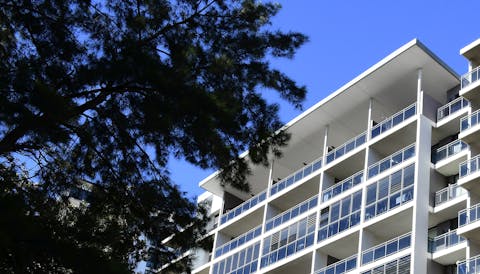
Hundreds of residents in a Sydney apartment complex, the 122-unit Mascot Towers, were evacuated last Sunday when cracks began to appear due to a serious structural failure. And it isn’t clear when the residents can return.
This crisis echoes the structural failure at Opal Tower and its evacuation on Christmas Eve last year. We have seen a series of serious building failures and fires in recent years. And state and federal governments have had more than year to act on recommendations for better construction regulations, but instead they’re shifting blame.
Although each building failure was different, the end result is the same: misery for the residents and a looming financial disaster for the owners.
Read more: Flammable cladding costs could approach billions for building owners if authorities dither
New South Wales Premier Gladys Berejiklian said:
We’re getting to the bottom of what happened. The NSW government will hold everybody to account, that’s our role.
But the government’s role is to regulate sufficiently to prevent building failures in the first place, not to hold people to account after the event.
Building regulations since the Great Fire of London
Prevention of construction failures has been the bedrock of building regulations ever since the Great Fire of London in 1666. In the aftermath, the English government realised there was not much use in raking through the ashes and trying to hold people to account, and that an ounce of prevention was worth a pound of cure. This led to the parliament passing regulations to prevent the spread of fire between buildings.
Governments all around the developed world took the lesson of the Great Fire to heart. Their common goal has been to proactively ensure buildings are constructed properly and are safe as a result.
This has been a pretty successful effort and most significant building failures since 1666 have contributed to a more comprehensive and effective regulatory regime.
Serious building failures appear to be more frequent
Prior to the Opal Tower emergency, there had been only one significant evacuation of a multi-unit residential building in NSW due to structural failure. That was a result of the 2009 gas explosion at Eastgate Towers in Bondi Junction.
However, depending on which research you read, either 72% or 97% of strata apartments suffer from serious defects when they’re finished.
There have also been a series of other problems with recent buildings. These include lead in water caused by imported brass plumbing components, non-complying imported electrical cables and failures in the installation of fire doors, fire walls and fire door frames.
Read more: Australia has a new National Construction Code, but it's still not good enough
Why has this happened?
The states progressively introduced the Building Code of Australia (now the National Construction Code) during the 1990s as part of an agreed plan between the states and the federal government to make building regulations less prescriptive.
The aim was to reduce the cost of construction by favouring “innovation” over conservative “deemed to satisfy” regulations. Innovation, in these terms, meant finding ways to make buildings cheaper to build.
This move coincided with the globalisation of the building materials supply industry and a boom in the construction of tall apartment buildings in Australia.
Some of the innovation has been innocuous, or even beneficial, such as the introduction of a variety of lightweight interior wall systems, but some have resulted in substantial remediation bills – combustible cladding being the prime example. Inspection and responsibility for the plethora of imported components is virtually non-existent.
Read more: Don't overlook residents' role in apartment building safety
The downstream cost of failure has landed squarely in the laps of the building owners, many of them owners of tall apartments.
It’s difficult to estimate the total bill for remedial works to tall apartment buildings built over the last 25 years, but it may well exceed the Productivity Commission estimates of savings resulting from the introduction of the National Construction Code.
Blame shifting and ineffective regulations
The federal minister responsible for building regulations, Karen Andrews, says the states are to blame.
And some states, including NSW, have resorted to tough talk about crackdowns on “dodgy” certifiers and “dodgy” builders. In reality, the problem is dodgy government regulation, by both federal and state governments.
The federal and state governments already have an initial plan for fixing these problems. The Shergold-Weir report was delivered to the Building Ministers’ Forum in February 2018.
As the report said:
After having examined the matters put to us, we have concluded that the nature and extent [of building defects] are significant and concerning. The problems have led to diminishing public confidence that the building and construction industry can deliver compliant, safe buildings which will perform to the expected standards over the long term.
Since then, state and federal governments have done almost nothing to implement the recommendations of the report, despite the 2018 Christmas Eve failure at Opal and the fire at Neo200 in Melbourne the following February.
The report itself states:
The recommendations have been designed to form a holistic and structured framework to improve the compliance and enforcement systems of the [National Construction Code] across the country. They form a coherent package. They would best be implemented in their entirety.
In NSW, the published response to Shergold-Weir is a patchwork focusing on holding people to account after a building construction event. This is the reverse of the proactive approach developed following the Great Fire of London.
Read more: Beyond Opal: a 10-point plan to fix the residential building industry
The NSW government is set to appoint a building commissioner to oversee qualifications and to review building documentation.
But this will likely not achieve much, unless the government commits to upskilling workers throughout the industry and backs up desktop audits by increasing direct inspections on site. Neither of these things appears to be part of its plan.
All governments must take an active role in fixing the defective regulatory regime they have created. If they can’t get on with this process in a timely way, we will need yet another royal commission to sort it out.
The least Premier Berejiklian can do is to treat the Mascot Towers and Opal events in the same way the government treats natural disasters and provide housing assistance to residents who have been displaced through no fault of their own.![]()
Geoff Hanmer, Adjunct Lecturer in Architecture, UNSW
This article is republished from The Conversation under a Creative Commons license. Read the original article.
Why regional universities are at risk of going under

Unless the federal government changes its funding policy for universities, less well-off ones, particularly regional universities, are going to fail.
In Britain, it is already happening. Several bankruptcies are imminent.
In Australia, many are clearly in financial difficulties and are trying to raise money any way they can.
During the election campaign, ABC’s Four Corners highlighted questionable practices in the recruitment of full-fee paying international students at institutions including Murdoch University and Central Queensland University.
Desperate for funds…
The Tertiary Education Quality and Standards Agency has found “severe shortcomings” in the performance of Charles Sturt University, sufficient to reduce its period of accreditation from seven to four years.
In an extraordinary move, the departing Vice Chancellor of the University of Canberra has asked his staff to donate up to A$1,000 per annum to “support students”.
It’s easy to blame the universities themselves, but it is the government that has designed the policies that have forced them up against a financial brick wall.
This situation has come about partly because of a pea and thimble trick performed by both Labor and the Coalition. While recurrent funding has risen due to the Rudd-Gillard-Rudd government’s introduction of “demand driven” funding, it has been followed by a withdrawal of capital funding.
…but it’s not their fault
In 2015 the Coalition axed A$11 billion Education Investment Fund set up by Labor in 2008 to maintain infrastructure “in urgent need of attention”. In 2017 it froze recurrent funding.
Four years after the Education Investment Fund was axed, estimates from the higher education facilities consultancy ARINA put the maintenance deficit at more than the A$23 billion dollars that was estimated at the time. That’s what’s needed to return campuses to a condition where they are fit for purpose.
Although the new government has announced small additional funding for regional universities, it is nowhere near enough. Many have dilapidated campuses that are hard to work or study in. University buildings constructed during the 1960s are nearing the end of their useful lives.
It’s alright for the Group of Eight
The current funding model works best for the prestigious Group of Eight (Go8) universities – those named after the cities of Sydney, Melbourne and Adelaide as well as the states of NSW, Queensland and Western Australia plus Monash University and the Australian National University.
The universities in Sydney and Melbourne have the best access to high-quality full-fee paying international students, although even for them there are issues.
The Go8 universities require huge amounts of capital to build facilities to support research in the STEM disciplines: science, technology, engineering and medicine. Under current funding policy, most of which now has to come from recurrent student income.
The proportion of international students at the biggest Go8 campuses climbs year by year. And they are continuing to expand domestic enrolments as fast as they can.
For the rest, options to fund capital works are limited. While some may have recruited international students regardless of quality, others are getting new buildings by doing deals with property developers.
There are few options for others
Western Sydney University is renting its new “state of the art” campus in the Parramatta CBD. Unfortunately, the rental model carries risks because it narrows the options for reducing costs if revenue falls.
Revenue can fall for many reasons outside the control of the university, including an abrupt reduction in the number of international students due to geopolitical factors or changes in government policy on immigration.
Rent is also more expensive than direct funding because the price charged includes margins for commercial risk and profit. The property sector likes the idea, but then it would, wouldn’t it?
The best way to fund needed capital works on university buildings, and make sure they survive, is for the government to return to making capital payments on the basis of need. It would mean that universities facing a chronic shortage of capital wouldn’t need to resort to extreme measures.
Direct funding would mean they would have to conform to government-imposed area and cost standards for buildings. This would put welcome downward pressure on building costs, which have soared for some of the big city universities that have access to cash from international students.
City universities win design awards
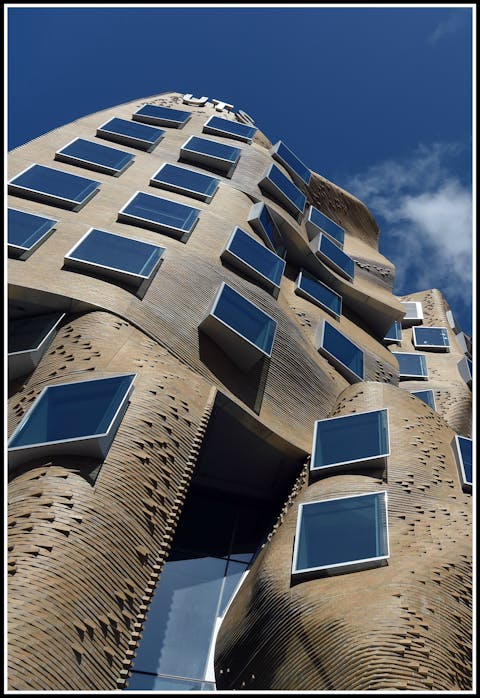
General academic buildings, and those providing offices and teaching space, are in some cases being delivered for twice as much as they were 20 years ago, corrected for inflation, in large part because they have become unnecessarily elaborate, in part to attract foreign students.
The Monash learning and teaching building and the University of Melbourne architecture building are examples, as is the A$180 million University of Technology Sydney business school building.
Instead of making every new university building an award-winning icon, we ought to be content with making at least some of them just good.
Providing capital funding to universities is likely to cost at least an extra A$1.5 billion a year. But that’s small compared to the more than A$30 billion international education exports are said to pump into the economy.
It is also small compared to what would happen if they folded or failed to deliver the research we need.
Others can afford little
The sector can help its own case by focusing more on building costs and less on winning design awards. University peak bodies in Britain play an active role in benchmarking building and operational costs. Universities Australia should consider doing the same.
It ought to be in a position to document improvements in the operational efficiency of universities and highlight the magnitude of the maintenance funding needed. At the moment, it is not.
Read more: How has education policy changed under the Coalition government?
No one, including the government, really wants a university to fail. The cost of recovery would probably end up being borne taxpayers and the impact on students would be devastating.
It is in the interests of all Australians to have a university funding model that does not send less well-off universities to the wall, including most of our regional universities.
The current model generates perverse incentives to reduce acceptance standards for international students, encourages universities to use expensive developer-provided sources of capital and has driven the creation of mega campuses that are more about income than student outcomes. We can and should do better.![]()
Geoff Hanmer, Adjunct Lecturer in Architecture, UNSW
This article is republished from The Conversation under a Creative Commons license. Read the original article.
Housing with buyer protection and no serious faults – is that too much to ask of builders and regulators?

Regulation of the Australian building industry is broken, according to the Shergold-Weir report to the Building Ministers’ Forum (BMF).
[…] we have concluded that [the] nature and extent [of problems] are significant and concerning. The problems have led to diminishing public confidence that the building and construction industry can deliver compliant, safe buildings which will perform to the expected standards over the long term.
You can say that again.
Just one of the issues identified in the report, combustible cladding, could affect over 1,000 buildings across Australia. An unknown proportion of these are tall (four storey and above) residential strata buildings. Fears of rectification costs are starting to have severe impacts on the apartment market.
The cost of replacing combustible panels at the Lacrosse Apartments in Melbourne, which caught fire in 2014, will be at least A$5.7 million, plus A$6 million or so in consequential damages. The total cost of replacing combustible panels across Australia is unknown at this point, but is likely to run to billions of dollars.
Read more: Lacrosse fire ruling sends shudders through building industry consultants and governments
The Shergold-Weir report identifies a catalogue of other problems, including water leaks, structurally unsound roof construction and poorly constructed fire-resisting elements. Faults appear to be widespread.
A 2012 study by UNSW City Futures surveyed 1,020 strata owners across New South Wales and found 72% of respondents (85% in buildings built since 2000) knew of at least one significant defect in their complex. Fixing these problems will cost billions more.
Regulatory failures are not only “diminishing public confidence”, they have a direct impact on the hip pockets of many Australians who own a residential apartment. In short, building defects resulting from lax regulation are a multi-billion dollar disaster.
How could authorities let this happen?
A web of regulations and standards enacted by governments cover construction in Australia, but this regulation is centred on the National Construction Code (NCC). The Australian Building Codes Board (ABCB), a body controlled by the Building Ministers’ Forum, manages the NCC. The ABCB board comprises appointed representatives from the Commonwealth plus all the states and territories and a few industry groups.
It is such a complicated system that it is hard to identify any government, organisation or person that is directly responsible for its performance.
Read more: Australia has a new National Construction Code, but it's still not good enough
The NCC is supposed to create “benefits to society that outweigh costs” but it appears the ABCB may have been more focused on the need to “consider the competitive effects of regulation” and “not be unnecessarily restrictive” (Introduction to NCC Volume 1).
The BMF’s February 8 communique, issued after the fire in the Neo200 building in Melbourne, is straight out of the Yes Minister playbook:
Ministers agreed in principle to a national ban on the unsafe use of combustible ACPs (aluminium composite panels) in new construction, subject to a cost/benefit analysis being undertaken on the proposed ban, including impacts on the supply chain, potential impacts on the building industry, any unintended consequences, and a proposed timeline for implementation. Ministers will further consider this at their next meeting [in May this year].
This suggests the ministers are more concerned about possible impacts on the panel suppliers and the building industry than the consumer. The earliest a ban can take effect is in May. In the meantime, anecdotal evidence suggests buildings are still being clad in combustible ACP.
Thanks to the journalist Michael Bleby, we know governments and the ABCB failed to act in 2010 when presented with evidence that combustible ACP was not only a danger, but was also being widely used on tall residential buildings.
Bleby quoted ABCB general manager Neil Savery as saying neither his organisation, nor any of the states, was aware that builders were using the product incorrectly.
We also know that panel manufacturers, including the Australian supplier of Alucobond, actively lobbied building ministers. At the July 2011 BMF meeting, the ACT representative effectively vetoed an ABCB proposal to issue an advisory note on the use of combustible ACP.
We are entitled to ask why the ABCB and its staff, or the downstream regulators and their staff, did not know about serious fire problems with ACP that the technical press identified as long ago as 2000. The answer will be of particular interest to residents of tall apartment buildings clad in these panels, all of whom are now living with an active threat to their safety.
Read more: Cladding fire risks have been known for years. Lives depend on acting now, with no more delays
Consumers are owed better protection
While both Labor and Coalition governments have worked to improve consumer protection for people buying consumer goods, their record on housing, particularly apartments, is awful. While a consumer can be reasonably sure of getting restitution if they buy a faulty fridge, no such certainty exists if they buy a faulty house or apartment.
At the moment, the NCC does not have any focus on providing protection for buyers of houses or apartments. There are few requirements for the durability of components and astonishingly weak requirements for waterproofing. Under the NCC and its attached Australian Standards, particularly AS 4654.1 and 2-2012, a waterproof membrane could last, in practice, five minutes or 50 years.
Given the magnitude of the economic loss, it would be appropriate for the BMF and ABCB board to publicly admit they have failed. Since their appointments in November 2017 and January 2013 respectively, neither ABCB chair John Fahey nor Savery as general manager has remedied the situation. The Shergold-Weir report has not been implemented and the combustible cladding issues remain unresolved. It would be reasonable for Fahey to step down and for Savery to consider his future.
The next federal government should consider what further action should be taken, particularly in relation to individuals on the BMF and within the ABCB involved in the 2010-2011 decision not to issue the proposed advisory note on the use of ACP. Since the ABCB does not publish minutes and none of its deliberations are in the public domain no one knows what actually happened or who did what.
The new board should consider moving residential apartment buildings (Class 2 buildings in the NCC classification) from Volume 1 of the NCC to Volume 2, which controls detached and semi-detached housing. Volume 2 should then have as its overriding objective the protection of consumers.
The downstream regulators should focus on requiring builders to deliver residential buildings with no serious faults and providing simple mechanisms for redress if they don’t.
Surely this is not too much to ask.
This article has been updated to correct a reference to NCC volumes 1 and 2 – the latter controls detached and semi-detached housing.![]()
Geoff Hanmer, Adjunct Lecturer in Architecture, UNSW
This article is republished from The Conversation under a Creative Commons license. Read the original article.
Lacrosse fire ruling sends shudders through building industry consultants and governments
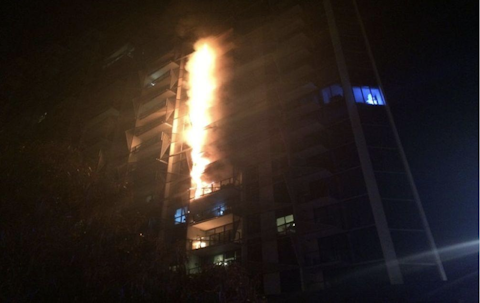
On the last day of summer for 2019, the Victorian Civil and Administrative Tribunal (VCAT) delivered a burst of sunshine to apartment owners at the high-rise Lacrosse building in the Melbourne Docklands precinct. Lacrosse suffered a serious cladding fire on November 24 2014, started by a single cigarette on a balcony. Last Thursday, Judge Ted Woodward ordered the owners be immediately paid A$5.7 million in damages.
The judge also indicated that the owners would receive most of the balance of their A$12.7 million claim – including nearly A$6 million in calculated costs of compliance with building codes.
However, in our adversarial legal system, there are losers as well as winners. The losers in this case are the fire engineer, the certifier and the architects.
The builder, LU Simon, was ordered to pay more than A$5.7 million to apartment owners. However, the architect, fire engineer and building certifier who worked on the project would pay most of that to LU Simon after Judge Woodward found they had breached contractual obligations.
Fire engineer Thomas Nicholas was ordered to pay 39% of the damages, certifier Gardner Group 35% and architects Elenberg Fraser 25%. Incredibly, the builder, LU Simon, is a winner, assessed to pay only 3% of the damages.
Read more: Cladding fire risks have been known for years. Lives depend on acting now, with no more delays
So shocking is the VCAT decision to architects that the national president of the Australian Institute of Architects suggested in an email to members last Friday that they might need to seek counselling.
The decision reminds architects and other consultants that abiding by common practice is no defence if that practice is inadequate. Even though an architect may work for the builder and be employed on a limited commission during construction, they still bear primary responsibility for the safety of the building as the “lead consultant”. According to the decision, architects and consultants are required to exercise high standards of professional judgement and skill even if their commissioning arrangements and fees militate this.
So is this a win for all owners?
It looks like a cause for celebration by the owners. But is it?
Well, for a start, this decision has taken over four years to emerge. It may yet be the subject of an appeal. In the meantime, owners and residents have had to live in a building that is not safe, although work to replace the cladding should be complete by May.
Judge Woodward said the decision applies to the specific circumstances of Lacrosse only, so the owners of other buildings, including Neo200, which was evacuated on February 4 after a similar fire, might not also be in the winner’s circle.
Read more: Don't overlook residents' role in apartment building safety
Fourteen of the Neo200 apartments are so badly damaged that rectification works could take up to a year to complete. If Lacrosse is any indication, the Neo200 legal case might take until 2022 to conclude.
The Lacrosse case ran for 22 days, involved five QCs, five juniors and an army of instructing solicitors, paralegals and expert witnesses. There were 91 volumes of documents tendered as evidence. Legal costs almost certainly exceeded A$2 million, or more than 15% of the damages sought.
Around the country, based on state audits, I estimate around 1,000 buildings have combustible aluminium composite panels on their facades. If they all generate a court case half as complex as Lacrosse, the legal bills alone could total over A$1 billion.
Government must also answer for deregulation
Those who eased the regulatory framework in place in Australia since the late 1980s share culpability with the consultants for the fires at Lacrosse and Neo200. Until the early 1990s, Australian building codes prohibited the use of combustible elements on the facades of tall buildings. Throughout the 1990s, the then Building Code of Australia (now the National Construction Code or NCC) was relaxed to a “performance standard”, which allowed builders and consultants to believe aluminium composite panels and timber were permissible.
By 2000, despite plenty of evidence that these panels were combustible and therefore not suitable as facade material on tall buildings, the market for them continued to grow. The Australian Building Codes Board did nothing about this, encouraging a potentially fatal error.
Read more: Cladding fires expose gaps in building material safety checks. Here's a solution
So far, on the regulatory side, no one has actually owned up to a mistake. However, the Building Ministers’ Forum is considering the 24 recommendations of a report it commissioned from Peter Shergold and Bronwyn Weir. New South Wales’ minister for innovation and better regulation, Matt Kean, has promised to crack down on dodgy certifiers. In the light of the cladding panel fiasco, he probably should be reviewing his own remit, which is based on the premise that less regulation is better.
The NCC has a goal to encourage innovation in building by allowing alternative solutions to “deemed to satisfy” provisions. Unfortunately, in the case of the cladding panels and other “innovations”, the cost savings may be only a tiny proportion of the costs of rectifying the problems.
Read more: Beyond Opal: a 10-point plan to fix the residential building industry
Penitent governments should ensure flammable cladding is replaced now, not next year and certainly not in five or six years’ time when another round of court cases are finally decided after appeal. Unless governments act to fix this mistake, one that they are substantially responsible for, someone is going to be killed in a cladding fire in Australia.
As Judith Hackitt, who headed the inquiry into the Grenfell Tower disaster, said last week, a Grenfell-like event in Australia is “entirely foreseeable”.![]()
Geoff Hanmer, Adjunct Lecturer in Architecture, UNSW
This article is republished from The Conversation under a Creative Commons license. Read the original article.
Cladding fire risks have been known for years. Lives depend on acting now, with no more delays

Geoff Hanmer, UNSW
The fire at the Neo200 building on Spencer Street in the Melbourne CBD this week has eerie similarities to the Grenfell Tower disaster. Fortunately, instead of 72 people dead as at Grenfell, only one person was hospitalised for smoke inhalation.
Read more: Cladding fires expose gaps in building material safety checks. Here's a solution
Nevertheless, the building industry has responded straight from the Grenfell song sheet. Rydon, the main contractor for the Grenfell Tower cladding, said the work:
… met all required building regulations – as well as fire regulation and Health & Safety standards – and handover took place when the completion notice was issued by Royal Borough of Kensington and Chelsea building control.
Rydon chief executive Robert Bond said:
I will do all I can to assist in this investigation in order to establish what caused this tragedy.
The Neo 200 architect, Hayball, stated:
Neo 200 achieved certification and approval from the building certifier and relevant authorities at the time. We welcome the opportunity to support any investigation into the incident by authorities.
This appears to be the property sector’s version of “thoughts and prayers”. We’re very sorry, but there’s nothing we can do.
Sadly, this is far from the truth. We have known of the risk for years and the problem can be rectified.
Governments must act to ensure the cladding identified as a fire risk on hundreds of buildings is replaced. Further delay in fixing an identified threat to life is unacceptable.
Before the Grenfell and Neo200 fires, Melbourne had a cladding fire at the Lacrosse building in 2014. This led to an audit of external wall cladding on buildings by the Victorian Building Authority.
Following the Grenfell fire, states conducted further audits. In October 2018, an update by the Victorian Cladding Taskforce stated:
Our investigations found dangerous materials are widely used on buildings throughout Victoria, a finding that is consistent with inquiries carried out interstate and internationally.
We now know that hundreds of residential buildings are rated as either a moderate or high risk by the New South Wales and Victorian governments. Over 350 buildings in Melbourne alone are rated “high risk”. Neo200 was regarded as only a “moderate risk”.
Residential buildings are particularly vulnerable to the effects of a cladding fire because people can be asleep and windows are often left open. The amount of smoke generated by the recent Neo200 fire is frightening.
In the UK, the central government has given local authorities the power to replace risky cladding. We should do the same here.
Governments should take rectification out of the hands of dithering strata committees and, if necessary, carry out the necessary work directly and recover the costs from the responsible parties.
How did we get to this point?
Polyethylene-cored aluminium sandwich panels – often referred to as aluminium composite panels (ACP), PE or PU panels – were developed 50 years ago, patented in 1971 and marketed as Alucobond. When the patent expired in 1991 other manufacturers entered the market, including products marketed as Reynobond (originally Reynolds Aluminium) and Alpolic (Mitsubishi Chemicals). Now, it is estimated over 200 manufacturers around the world produce ACP panels.
By the 1990s, ACP was gaining a level of acceptance in the Australasian construction market. This was aided by the introduction of performance requirements to replace a previous blanket ban on combustible materials being used on tall building facades. The timing of the relaxation of the Building Code of Australia and the introduction of ACP panels to the Australian market by multinational companies could be a coincidence.
By the end of the 1990s, there was growing evidence that the performance-based approach to facade fire protection was not working. Combustible cored sandwich panels were implicated as contributors to serious injuries and death. A notable example was a 1993 fire in the Sun Valley food-processing factory in Hereford in which two firefighters died. In 1997, the Museum of New Zealand (Te Papa) experienced a cladding fire during construction.
The general and technical press, including architectural magazines with wide circulation, reported cladding fires in various types of materials, including ACP.
What can be done to reduce the risk?
Clearly, a facade fire has serious consequences. The bedrock of all modern fire regulations is that a fire in a tall building must be confined to a single storey. A fire spreading from one floor to the next completely undermines all the elements of protection and control that make egress routes and firefighting viable.
As we saw at Grenfell, a fire that spreads up the facade and involves nearly every storey in the building can’t be brought under control.
By 2000, there was widespread concern among fire professionals and some regulators that ACP was a bomb waiting to go off. A paper by Dr Gordon Cooke clearly outlined the risks. It makes chilling reading in the light of the Grenfell disaster.
Luckily, most tall residential buildings in Australia with combustible ACP cladding have internal sprinkler systems – unlike Grenfell. We might also be able to buy some time by banning barbecues and smoking on balconies, but it is doubtful this will be 100% effective. Another possibility is to physically secure balcony doors shut, but many owners and tenants might strongly resist this draconian measure.
Read more: Don't overlook residents' role in apartment building safety
These measures still will not eliminate the risk of arson highlighted by the Victorian government.
As the Neo200 fire demonstrates, even a moderate risk is still quite risky. It is extraordinary that a fire allegedly lit by a single smouldering cigarette could spread so quickly across seven floors and generate so much potentially deadly smoke.
An urgent cladding replacement program certainly has its challenges. A campaign that involves working on several hundred buildings at once in Melbourne and Sydney might overload the industry.
Nevertheless, the situation has been created by a lack of action by governments. Only decisive government action can rectify it. No more “thoughts and prayers”, enquiries or investigations; just replace the cladding now.
Geoff Hanmer, Adjunct Lecturer in Architecture, UNSW
This article is republished from The Conversation under a Creative Commons license. Read the original article.
Beyond Opal: a 10-point plan to fix the residential building industry
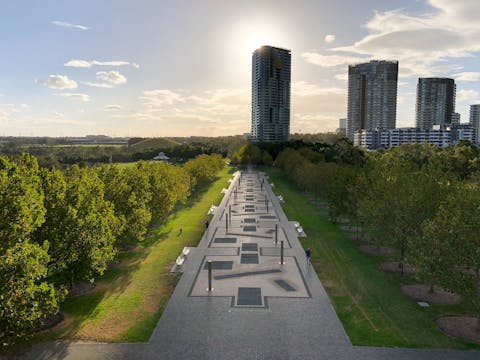
The failure of the Opal Tower building in Sydney has highlighted the poor quality of speculatively built multi-unit housing in Australia. The tower’s 392 apartments were evacuated on Christmas Eve when residents heard loud cracks and defects were found. So far, the only reaction from government has been a knee-jerk promise to crack down on shonky building certifiers (that’s you Matt Kean, minister for innovation and better regulation in New South Wales). Unfortunately, there is no evidence this will make any difference.
Planning policies embraced by the NSW and Victorian governments mean a greater percentage of new housing is being constructed in tall multi-unit developments than ever before, particularly in Sydney and Melbourne.
Between 50% and 80% of multi-unit buildings have defects serious enough to be the subject of strata committee involvement. Possibly close to 100% have significant defects at completion. Most of the problems are waterproofing issues (which may not be evident for years), malfunctioning services or a lack of proper compliance with fire codes and standards.
We can only fix this problem by changing the culture of the residential building industry.
Read more: The big lesson from Opal Tower is that badly built apartments aren't only an issue for residents
Ten steps governments can take
We don’t need another royal commission. Governments could implement all of the suggestions below using their existing powers.
1) Increase density by permitting more subdivisions on existing housing blocks rather than building tall buildings.
Two Torrens title townhouses can be built on a normal single-house quarter-acre block. Low-scale buildings will still suffer from defects, but are less problematic to build, inspect and repair than tall buildings and use simpler technology.
2) In the short term, provide occupation certificates to new residential buildings taller than three storeys only if they comply with an enhanced protocol of regulations and oversight.
State government would implement this, with a focus on waterproofing and fire performance.
A suitable code, standards and protocols could be developed in a few weeks. The necessary people to provide independent oversight could be drawn from qualified architects, builders and engineers who are able to pass a probing exam. They would be independent of the design and construction team. The government would fix their fees.
3) Develop a program to enhance the standards for residential building standards in the National Construction Code (NCC).
The current NCC codes for Class 2 buildings (home units) favour innovation and cost reduction over consumer protection. This is the wrong way around for housing. Section F, which covers health and amenity (including waterproofing), is weak and must be strengthened.
4) A voluntary quality scheme to star-rate all apartments, similar to ANCAP (Australasia New Car Assessment Program), might work with industry support.
The minimum standard permissible would comply with the enhanced standards. The NSW Building and Construction Council promoted a scheme in the 1990s but failed due to lack of government support. It was a good idea then, and it is still a good idea now.
5) If the industry won’t support a voluntary scheme, government should introduce a coercive qualified practitioner (QP) scheme.
This would be a permanent version of the short-term scheme. If a building goes bad, the QP could lose the right to practise as a QP as well as being liable to the owners.
6) Revitalise trade training and certification to ensure all trade workers are properly trained and certified.
Many trades on building sites have no training and are not licensed. The requirement to read directions and document work against procedures means everyone on site must be functionally literate. The goal should be to have 30% of people working on site at Certificate 4 level by 2025. 100% of building workers should be literate by 2025. This should be a national requirement, checked by inspectors.
7) All leading hands for any trade should be educated up to Certificate 4 level.
This should be independently verified to cut out shonky training providers. Leading hands in all trades should be licensed and responsible for the work they do.
8) Enhance licensing of builders and subcontractors to ensure people in charge on site are educated beyond Certificate 4.
All people occupying construction roles with management responsibility should have valid qualifications in architecture, structural engineering or building.
9) Consider additional laws on contract provisions to reduce the economic power disparity between developers, head contractors and subcontractors.
Unfair commercial pressures are at the heart of much bad building. We should do more to cushion the smaller players from the larger ones.
10) And, while we are at it, we should ensure a value-capture process accompanies the development of tall residential buildings so the cost of upgrading social infrastructure is recovered.
High-density, high-rise buildings massively increase loads on socially owned infrastructure, such as schools, libraries, hospitals, parks and sporting facilities. The developers of tall buildings should be made to contribute adequately to the economic cost of enhancing these provisions, which can involve solutions that are unusually expensive, such as high-rise schools.
Read more:
Explainer: what is ‘value capture’ and what does it mean for cities?
![]()
Geoff Hanmer, Adjunct Lecturer in Architecture, Univeristy of NSW, UNSW
This article is republished from The Conversation under a Creative Commons license. Read the original article.
There are lessons to be drawn from the cracks that appeared in Sydney's Opal Tower, but they extend beyond building certification

The reasons for the cracked concrete that triggered the evacuation – twice – of residents from Sydney’s Opal Tower over Christmas and the New Year are unknown and will take time to properly establish. Many commentators are jumping to the conclusion (yes that includes you, Senator Carr) that the problem is the result of the privatisation of building certification. Instead of being done by government or council inspectors, certification is now done by private contractors engaged by the developer.
It might well be a contributing factor, but what went wrong at Opal Tower is is much more complex than that. Making certification a government responsibility again won’t solve it.
Opal is unusual. Very few residential buildings in Australia have ever been evacuated due to construction defects, and fewer still because of structural cracking. The vast majority of construction defects in multi-unit residential buildings are waterproofing failures. Rather than creating short-term alarm, they create long-term misery. Because misery does not generate headlines, the problem of quality in multi-unit housing continues to be ignored by governments.
Most strata buildings are defective
Strata title allows each resident to own the space in which they live as well as a share of the common property including pipes and walls. It’s the way apartments are usually sold after they are developed.
We don’t have definitive, current data on the extent of defects in strata title buildings. Researchers from UNSW’s City Futures Research Centre have begun collecting the information for Sydney. But there are clear indications that defects are significant and widespread.
A 2012 study by City Futures surveyed 1,020 strata owners across NSW, and found 72% of all respondents (85% in buildings built since 2000) knew of at least one significant defect in their complex.
In 2017 a City of Sydney survey identified defects and maintenance as the top concern of owner occupiers of apartments, along with short-term letting through organisations such as Airbnb.
Unfortunately for those keen to leap to conclusions about certification, studies showed the same thing back in the early 1990s when certification was largely in the hands of local governments. In fact, studies have found the same thing ever since speculative housing became common in Australia, from the end of World War One.
In fact, ever since speculative housing development and investment has become common (after World War I in Australia), residential construction defects have been a concern both here and overseas.
The market for residential buildings is extremely competitive, and controlling the cost of construction is one of the key factors in making a profit. Sometimes, the urge to maximise profit dominates to the extent that both short and long-term construction failures are inevitable.
It’s the consequence of cost control
There are, of course, reputable developers and builders, but reputation usually finishes last, undercut by less-reputable players who produce buildings that are slightly cheaper.
Defects in single-storey speculative houses with pitched roofs are probably just as common as defects in multi-unit dwellings with flat roofs, but they are much easier to fix because the houses are close to the ground and no strata committee is involved.
They are also much easier to find; a competent building inspection initiated by a purchaser is normally enough to protect the buyer. On the other hand, a building inspection of a single unit in a multi-unit development is highly unlikely to find defects which are located elsewhere in the common property of a building.
There are 653 apartments in the Meriton-developed Regis Towers, for example, which was the subject of a long-running legal action for defects.
Intervening at certification is too late
The only practical way to make multi-unit dwellings a good investment for the residents and a decent place to live is for government to take a pro-active role in driving quality throughout the design and construction process, not just at the end when the building is certified for occupation, or at the beginning when it gets a development approval.
It is a simple reality that no other actor in the construction process has the capacity to take this role. It is also simpler and cheaper to build in quality than to rectify defects.
Often, a $1 detail realised for fifty cents will cause endless grief and cost thousands of dollars to fix.
Reducing the amount of rectification required will improve sustainability outcomes by containing the amount of embodied carbon incorporated in the building.
If the building performs well, it will have a longer life and that will reduce the need to eventually replace it with a new building; again saving materials and improving the outcome for embodied carbon. It is worth remembering that 20 million tonnes of construction and demolition waste are produced in Australia each year.
Governments have been reluctant to intervene early
Governments have as good as ignored the problem of defects in multi-unit residential construction even though they have been aware of it for years.
This is particularly concerning because the state governments in NSW and Victoria have been busy spruiking this type of accommodation as the solution to the pressures of rising populations in Sydney and Melbourne. Given this, the protections for apartment owners under existing legislation are ludicrously slight.
Unfortunately, compliance with the National Construction Code (NCC) in its current form is no guarantee. There are so many ambiguities and grey areas in the NCC and in the way that it is applied that it is a guarantee of almost nothing, particularly when it comes to waterproofing.
Read more: Why investor-driven urban density is inevitably linked to disadvantage
A simple example is the construction of balconies with flat slabs, which is perfectly acceptable under the NCC. The floor slab is constructed as a single plane from the interior to the exterior of the building with the waterproof barrier at the balcony being provided by a masonry wall or a concrete ridge on top of the slab.
This design almost always leaks within a few years. The reliable solution is to cast the slab with a step, but this is more expensive and as a consequence is rare. Cut-price membranes under tiled terraces are also common, causing leaks, mould and misery, despite arguably complying with the provisions of the NCC.
Fortunately, there is plenty that government could do to improve quality of multi-unit construction without affecting prices much.
Five stars. Information could drive standards
One clear way forward is to make the construction quality of a building more transparent to buyers.
This could be achieved by introducing a similar sort of quality assurance scheme to the one government runs to improve safety in cars; a five-star rating.
People are free to buy a two-star car, but for obvious reasons, not many do, even if they are cheap. Similarly, it is unlikely that many people would buy a two-star unit.
It would be perfectly possible to star rate multi-unit housing for construction quality using an independent assessment body against a transparent set of criteria.
It’s been tried before
Such a quality assurance scheme was introduced by the now defunct Building and Construction Council (BACC) in NSW during the 1990s, but unfortunately foundered due to a lack of funding and will from Bob Carr’s government. This was a pity, as the scheme was designed to drive quality through the whole of the building process, from design to completion.
It still provides a perfectly valid model for a policy that would actually do something to improve multi-unit construction quality at a cost which is minimal in relation to the value of the benefits produced. If a building is built correctly in the first place, then owners will not need to rely on shonky fly-by-night builders and developers for rectification works nor need to claim against complex insurance policies.
If the NSW and Victorian governments are serious about having a greater proportion of people live in multi-unit developments, they have a responsibility to do something about their quality before we are left with a overhang of misery, leaks and failures. Just ask the residents and owners of Opal Tower.![]()
Geoff Hanmer, Adjunct Lecturer in Architecture, UNSW
This article is republished from The Conversation under a Creative Commons license. Read the original article.
